Paul van Yperen's Blog, page 195
June 4, 2020
Richard Tauber
Austrian opera singer Richard Tauber (1891-1948) was one of the world's finest Mozartian tenors of the 20th century. With his monocle and high hat, he became the 'epitome of Viennese charm' with such popular musical films as Das Land des Lächelns/The Land of Smiles (1930) and Melodie der Liebe/Right to Happiness (1932).
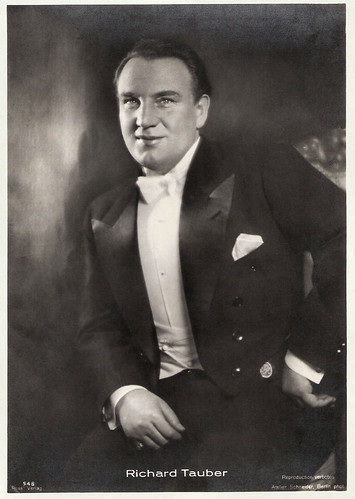
German postcard in the Ross Luxusklasse series by Ross Verlag, no. 548, 1919-1924. Photo: Atelier Schneider, Berlin.
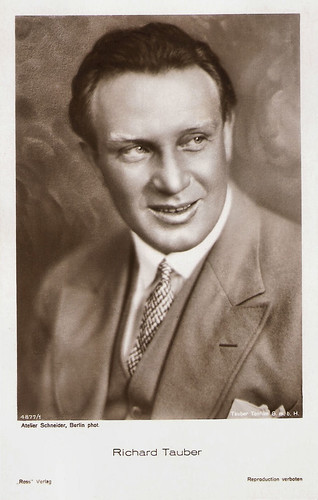
German postcard by Ross Verlag, no. 4877/1, 1929-1930. Photo: Atelier Ernst Schneider, Berlin / Tauber Tonfilm G.m.b.H.
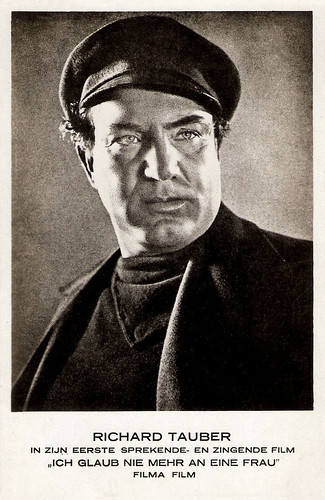
Dutch postcard. Photo: Filma Film. Publicity still for Ich glaub nie mehr an eine Frau/Never Trust a Woman (Max Reichmann, 1930).
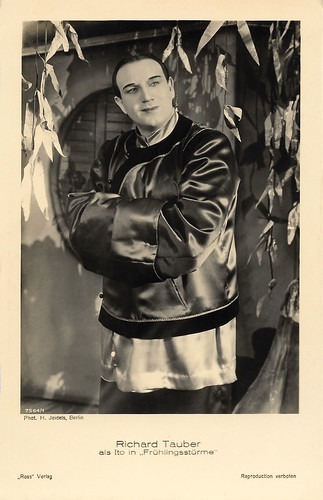
German postcard by Ross Verlag, no. 7564/1, 1932-1933. Photo: H. Jeidels, Berlin. Richard Tauber as Ito in tha stage operetta 'Frühlingsstürme' (1933, Spring Storms). Jaromir Weinberger’s operetta 'Frühlingsstürme' was "the last Weimar Republic operetta”. It was written for Richard Tauber and premiered at the end of January 1933. After only 20 performances – disturbed by rioting Nazi troups – the show was gone, and forgotten, except for a few obligatory Tauber recordings and this postcard. In 2019, 'Frühlingsstürme' was finally restaged at the Komische Oper in Berlin.
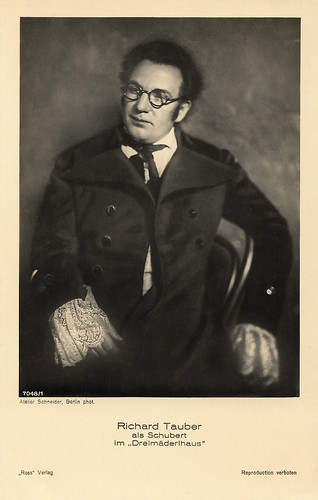
German postcard by Ross Verlag, no. 7048/1, 1932-1933. Photo: Atelier Schneider, Berlin. Richard Tauber as composer Franz Schubert in Blossom Time (Paul Stein, 1934), in Germany known as 'Das Driemäderlhaus' (House of the Three Girls). Tauber played Schubert in several productions and tours of 'Das Dreimäderlhaus' in Europe, first at Plauen, Germany, on 24 January 1920, and then in five performances of the original version at the Theatre an der Wien in October 1921. He presented a new version of it in German in 1933 at the Aldwych Theatre under the title 'Lilac Time', adapted by himself and Sylvio Mossée. Tauber then made the 1934 film version.
Illegitimate Son
Richard Tauber was born in Linz, Austria in 1891. He was the illegitimate son of soubrette Elisabeth Seiffert and actor and theatre director Richard Anton Tauber. He was given the name Richard Denemy (Denemy being his mother's maiden name).
The boy was raised by his mother until he was seven and later by his father, who officially gave Richard his name. At the Hoch Conservatory in Frankfurt, he studied piano, composition and conducting, subjects which stood Tauber in good stead in later years. He was heard singing by the well-known voice teacher Professor Carl Beines, who encouraged him to sing more quietly and to interprete the works of Wolfgang Amadeus Mozart.
In 1913 he made his stage debut as Tamino in Mozart's 'Die Zauberflöte' (The Magic Flute) with the help of his father, who had become the Intendant of both the Stadt-Theater in Chemnitz. He was quickly engaged for major roles at the Dresden Opera, where he stayed until 1926. Then he joined the Vienna Staatsoper.
In these years, he worked up a rich repertoire of roles in such operas as 'Don Giovanni', 'Tosca', and 'Carmen'. Franz Lehár composed several operettas specifically designed for Tauber's voice, including 'Der Zarewitsch' (1926), 'Friederike' (1928), and 'Das Land des Lächelns/The Land of Smiles' (1929). Tauber made over seven hundred gramophone records, mainly for the Odeon Records label. His recordings include opera, operetta, art song, popular tunes and novelties.
He also tested the then new talking pictures in such popular musical films as Ich küsse Ihre Hand, Madame/I Kiss Your Hand Madame (Robert Land, 1929) with Marlene Dietrich , Das Land des Lächelns/The Land of Smiles (Max Reichmann, 1930), and Melodie der Liebe/Right to Happiness (Georg Jacoby, 1932).
Richard Tauber was elegant in appearance. He had a slight squint in his right eye and disguised it by wearing a monocle which, when accompanied by a top hat, added to the elegant effect. For many people he became the epitome of Viennese charm.
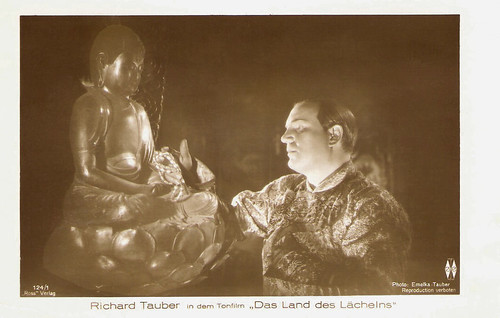
German postcard by Ross Verlag, no. 124/1. Photo: Emelka / Tauber. Richard Tauber in Das Land des Lächelns/Land of Smiles (Max Reichmann, 1930).
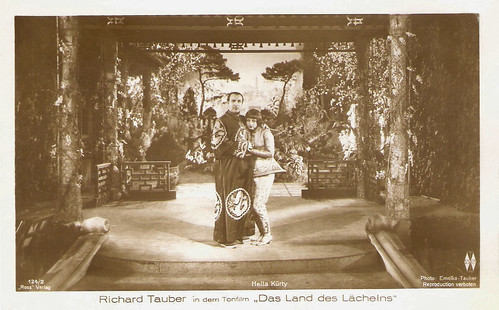
German postcard by Ross Verlag, no. 124/2. Photo: Emelka / Tauber. Richard Tauber and Hella Kürty in Das Land des Lächelns/Land of Smiles (Max Reichmann, 1930).
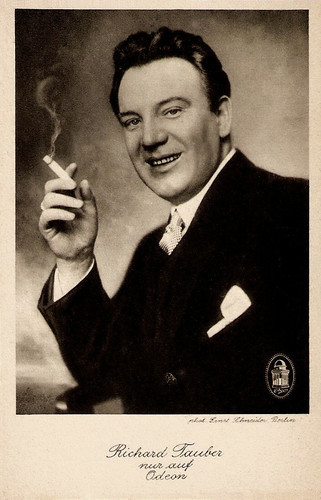
German postcard by Odeon. Photo: Ernst Schneider, Berlin.
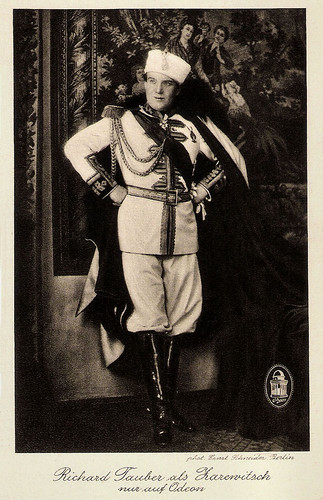
German postcard by Odeon. Photo: Ernst Schneider, Berlin. Caption: Richard Tauber as Zarewitsch (Tsarevich) only on Odeon.
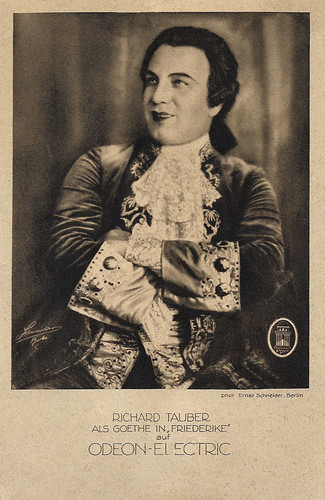
German postcard by Odeon-Electric. Photo: Ernst Schneider, Berlin. Richard Tauber as Goethe in the operetta Friederike in 1928.
Land Without Music
In 1933, Richard Tauber was assaulted by a group of Nazi Brownshirts because he was part Jewish on his father's side. Despite his fame and popularity, he decided to leave Hitler's Germany for his native Austria.
He often worked in London where he appeared in some musical films. He earned fine notices for his portrayal of composer Franz Schubert in Blossom Time (Paul L. Stein, 1934), as well as for his work in Heart's Desire (Paul L. Stein, 1935), and Land Without Music (Walter Forde, 1936).
He married his British co-star Diana Napier. They appeared together again in the Leoncavallo tragedy Pagliacci (Karl Grune, 1936). In 1938, he made his London operatic debut in Die Zauberflöte under Sir Thomas Beecham.
Earlier that year, Nazi Germany annexed Austria and Tauber left Austria for good. Despite receiving lucrative offers from the USA, he remained in the UK for the entire war.
In 1947, Tauber sought help for an aggravated cough which was subsequently diagnosed as lung cancer. The Vienna State Opera was in London for a short season at the Royal Opera House at Covent Garden and they invited Tauber to sing one performance with his old company. He gave a bravura performance as Don Ottavio in 'Don Giovanni' and fulfilled this engagement the following day at the Camden Theatre, having begun and ended his formidable career performing Mozart.
Three days later, he entered a London hospital to have his left lung removed, but it was too late. Richard Tauber died of complications in January 1948. He was 56. In the musical bio Du bist die Welt für mich/You Are the World for Me (Ernst Marischka, 1953) Rudolf Schock acted and sang the role of Tauber.
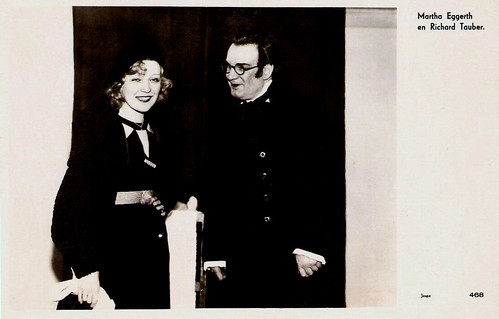
Dutch postcard by JosPe, no. 468. With Marta Eggerth.
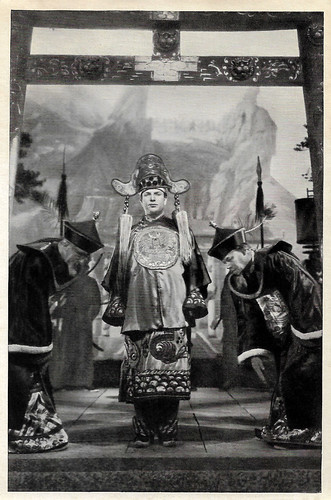
German collectors card in the series 'Vom Werden deutscher Filmkunst - Der Tonfilm', album no. 11, picture no. 25. Photo: Bayerische Filmges. / Ross Verlag. Richard Tauber in Das Land des Lächelns/The Land of Smiles (Max Reichmann, 1930).
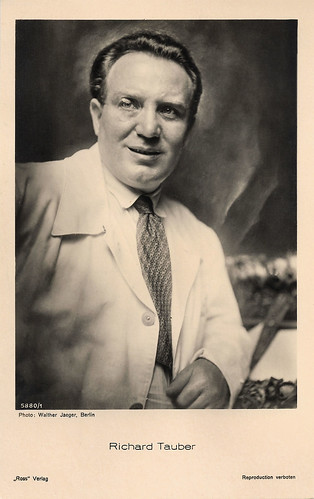
German postcard by Ross Verlag, no. 5880/1, 1930-1931. Photo: Walther Jaeger, Berlin.
[image error]
German postcard. Richard Tauber and Petra Unkel in Melodie der Liebe (Georg Jacoby, 1932). Caption: We will soon bring the artistic film event of 1932. Chamber singer Richard Tauber with his daughter in the film "Melody of Love". Don't miss out on this real film wonder.
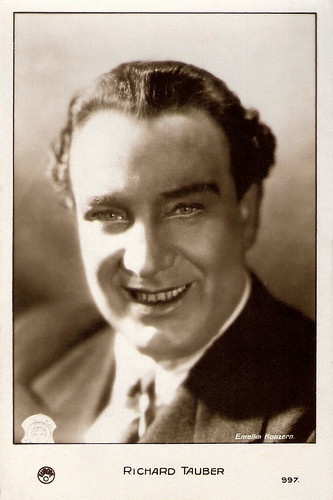
French postcard in the Europe series, no. 997, ca. 1932. Photo: Emelka Konzern.
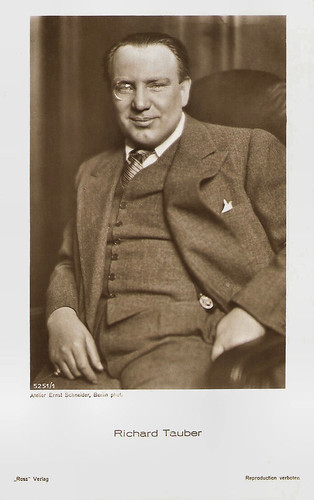
German postcard by Ross Verlag, no. 5251/1, 1930-1931. Photo: Atelier Ernst Schneider, Berlin.
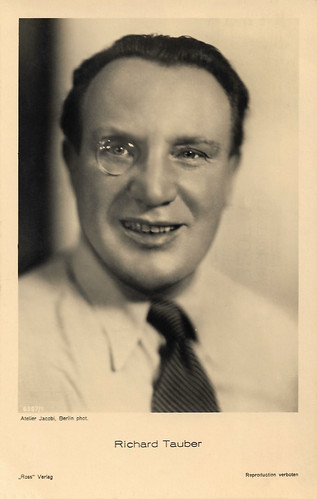
German postcard by Ross Verlag, no. 6307/1, 1931-1932. Photo: Atelier Jacobi, Berlin.
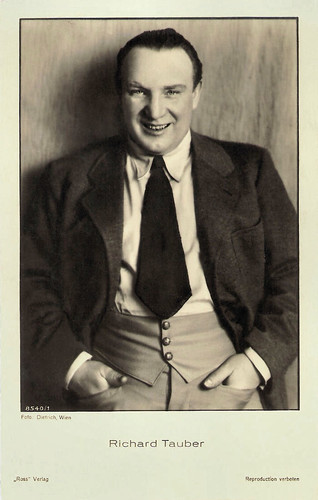
German postcard by Ross Verlag, no. 8540/1, 1933-1934. Photo: Dietrich, Wien.
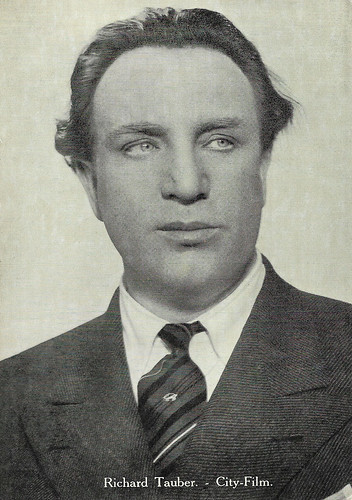
Dutch postcard by Smeets & Schippers, Amsterdam. Photo: City-Film.
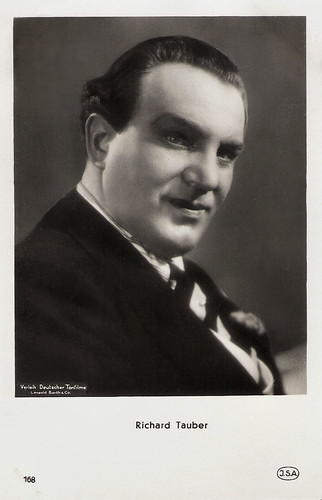
Dutch postcard by J.S.A., no. 168. Photo: Verleih Deutscher Ton-Filme / Leopold Barth & Co.
Sources: (IMDb), Trevor Peak (Find A Grave), Wikipedia and .

German postcard in the Ross Luxusklasse series by Ross Verlag, no. 548, 1919-1924. Photo: Atelier Schneider, Berlin.

German postcard by Ross Verlag, no. 4877/1, 1929-1930. Photo: Atelier Ernst Schneider, Berlin / Tauber Tonfilm G.m.b.H.

Dutch postcard. Photo: Filma Film. Publicity still for Ich glaub nie mehr an eine Frau/Never Trust a Woman (Max Reichmann, 1930).

German postcard by Ross Verlag, no. 7564/1, 1932-1933. Photo: H. Jeidels, Berlin. Richard Tauber as Ito in tha stage operetta 'Frühlingsstürme' (1933, Spring Storms). Jaromir Weinberger’s operetta 'Frühlingsstürme' was "the last Weimar Republic operetta”. It was written for Richard Tauber and premiered at the end of January 1933. After only 20 performances – disturbed by rioting Nazi troups – the show was gone, and forgotten, except for a few obligatory Tauber recordings and this postcard. In 2019, 'Frühlingsstürme' was finally restaged at the Komische Oper in Berlin.

German postcard by Ross Verlag, no. 7048/1, 1932-1933. Photo: Atelier Schneider, Berlin. Richard Tauber as composer Franz Schubert in Blossom Time (Paul Stein, 1934), in Germany known as 'Das Driemäderlhaus' (House of the Three Girls). Tauber played Schubert in several productions and tours of 'Das Dreimäderlhaus' in Europe, first at Plauen, Germany, on 24 January 1920, and then in five performances of the original version at the Theatre an der Wien in October 1921. He presented a new version of it in German in 1933 at the Aldwych Theatre under the title 'Lilac Time', adapted by himself and Sylvio Mossée. Tauber then made the 1934 film version.
Illegitimate Son
Richard Tauber was born in Linz, Austria in 1891. He was the illegitimate son of soubrette Elisabeth Seiffert and actor and theatre director Richard Anton Tauber. He was given the name Richard Denemy (Denemy being his mother's maiden name).
The boy was raised by his mother until he was seven and later by his father, who officially gave Richard his name. At the Hoch Conservatory in Frankfurt, he studied piano, composition and conducting, subjects which stood Tauber in good stead in later years. He was heard singing by the well-known voice teacher Professor Carl Beines, who encouraged him to sing more quietly and to interprete the works of Wolfgang Amadeus Mozart.
In 1913 he made his stage debut as Tamino in Mozart's 'Die Zauberflöte' (The Magic Flute) with the help of his father, who had become the Intendant of both the Stadt-Theater in Chemnitz. He was quickly engaged for major roles at the Dresden Opera, where he stayed until 1926. Then he joined the Vienna Staatsoper.
In these years, he worked up a rich repertoire of roles in such operas as 'Don Giovanni', 'Tosca', and 'Carmen'. Franz Lehár composed several operettas specifically designed for Tauber's voice, including 'Der Zarewitsch' (1926), 'Friederike' (1928), and 'Das Land des Lächelns/The Land of Smiles' (1929). Tauber made over seven hundred gramophone records, mainly for the Odeon Records label. His recordings include opera, operetta, art song, popular tunes and novelties.
He also tested the then new talking pictures in such popular musical films as Ich küsse Ihre Hand, Madame/I Kiss Your Hand Madame (Robert Land, 1929) with Marlene Dietrich , Das Land des Lächelns/The Land of Smiles (Max Reichmann, 1930), and Melodie der Liebe/Right to Happiness (Georg Jacoby, 1932).
Richard Tauber was elegant in appearance. He had a slight squint in his right eye and disguised it by wearing a monocle which, when accompanied by a top hat, added to the elegant effect. For many people he became the epitome of Viennese charm.

German postcard by Ross Verlag, no. 124/1. Photo: Emelka / Tauber. Richard Tauber in Das Land des Lächelns/Land of Smiles (Max Reichmann, 1930).

German postcard by Ross Verlag, no. 124/2. Photo: Emelka / Tauber. Richard Tauber and Hella Kürty in Das Land des Lächelns/Land of Smiles (Max Reichmann, 1930).

German postcard by Odeon. Photo: Ernst Schneider, Berlin.

German postcard by Odeon. Photo: Ernst Schneider, Berlin. Caption: Richard Tauber as Zarewitsch (Tsarevich) only on Odeon.

German postcard by Odeon-Electric. Photo: Ernst Schneider, Berlin. Richard Tauber as Goethe in the operetta Friederike in 1928.
Land Without Music
In 1933, Richard Tauber was assaulted by a group of Nazi Brownshirts because he was part Jewish on his father's side. Despite his fame and popularity, he decided to leave Hitler's Germany for his native Austria.
He often worked in London where he appeared in some musical films. He earned fine notices for his portrayal of composer Franz Schubert in Blossom Time (Paul L. Stein, 1934), as well as for his work in Heart's Desire (Paul L. Stein, 1935), and Land Without Music (Walter Forde, 1936).
He married his British co-star Diana Napier. They appeared together again in the Leoncavallo tragedy Pagliacci (Karl Grune, 1936). In 1938, he made his London operatic debut in Die Zauberflöte under Sir Thomas Beecham.
Earlier that year, Nazi Germany annexed Austria and Tauber left Austria for good. Despite receiving lucrative offers from the USA, he remained in the UK for the entire war.
In 1947, Tauber sought help for an aggravated cough which was subsequently diagnosed as lung cancer. The Vienna State Opera was in London for a short season at the Royal Opera House at Covent Garden and they invited Tauber to sing one performance with his old company. He gave a bravura performance as Don Ottavio in 'Don Giovanni' and fulfilled this engagement the following day at the Camden Theatre, having begun and ended his formidable career performing Mozart.
Three days later, he entered a London hospital to have his left lung removed, but it was too late. Richard Tauber died of complications in January 1948. He was 56. In the musical bio Du bist die Welt für mich/You Are the World for Me (Ernst Marischka, 1953) Rudolf Schock acted and sang the role of Tauber.

Dutch postcard by JosPe, no. 468. With Marta Eggerth.

German collectors card in the series 'Vom Werden deutscher Filmkunst - Der Tonfilm', album no. 11, picture no. 25. Photo: Bayerische Filmges. / Ross Verlag. Richard Tauber in Das Land des Lächelns/The Land of Smiles (Max Reichmann, 1930).

German postcard by Ross Verlag, no. 5880/1, 1930-1931. Photo: Walther Jaeger, Berlin.
[image error]
German postcard. Richard Tauber and Petra Unkel in Melodie der Liebe (Georg Jacoby, 1932). Caption: We will soon bring the artistic film event of 1932. Chamber singer Richard Tauber with his daughter in the film "Melody of Love". Don't miss out on this real film wonder.

French postcard in the Europe series, no. 997, ca. 1932. Photo: Emelka Konzern.

German postcard by Ross Verlag, no. 5251/1, 1930-1931. Photo: Atelier Ernst Schneider, Berlin.

German postcard by Ross Verlag, no. 6307/1, 1931-1932. Photo: Atelier Jacobi, Berlin.

German postcard by Ross Verlag, no. 8540/1, 1933-1934. Photo: Dietrich, Wien.

Dutch postcard by Smeets & Schippers, Amsterdam. Photo: City-Film.

Dutch postcard by J.S.A., no. 168. Photo: Verleih Deutscher Ton-Filme / Leopold Barth & Co.
Sources: (IMDb), Trevor Peak (Find A Grave), Wikipedia and .
Published on June 04, 2020 22:00
June 3, 2020
Photo by d'Ora
Atelier d’Ora was one of the most important Austrian photo salons of the first decades of the 20th century. The studio was founded in 1907 by Dora Kallmus with the support of Arthur Benda, who was the technical director. Kallmus, who took the pseudonym Madame d’Ora in 1907, quickly became with her studio one of the most sought-after of Vienna's society photographers. She also portrayed many European film stars in her Vienna salon and from 1925 on also in her second studio in Paris.
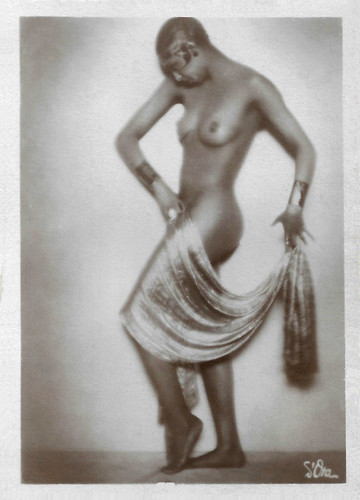
Small French card by Columbia. Photo: d'Ora.
Josephine Baker (1906-1975) was well-known as a singer and dancer. In 1925 she became an instant success in Paris, because of her erotic dance. She also performed in a handful of silent and early sound films, La Sirene des Tropiques (1927), Zouzou (1934), and La princesse TamTam (1935).
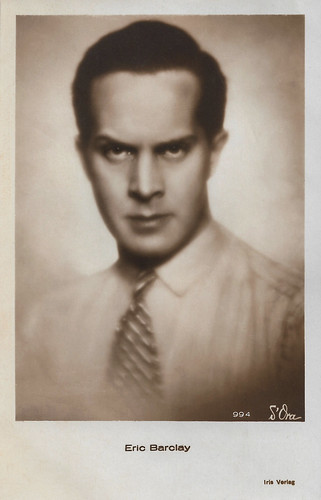
Austrian postcard by Iris Verlag, no. 994. Photo: d'Ora.
Eric Barclay (1894-1938) was a Swedish film actor. Barclay became a prominent actor in French silent films of the early 1920s, often working with director Jacques de Baroncelli. He also appeared in German and British films and those of his native Sweden.
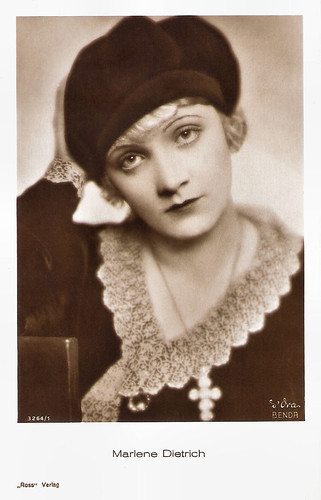
German postcard by Ross Verlag, no. 3264/1, 1928-1929. Photo: d'Ora / Arthur Benda.
Marlene Dietrich (1901-1992) is regarded as the first German actress to become successful in Hollywood. Throughout her long career, she constantly re-invented herself, starting as a cabaret singer, chorus girl and film actress in 1920s Berlin, she became a Hollywood movie star in the 1930s, a World War II frontline entertainer, and finally an international stage show performer from the 1950s to the 1970s, eventually becoming one of the entertainment icons of the 20th century.
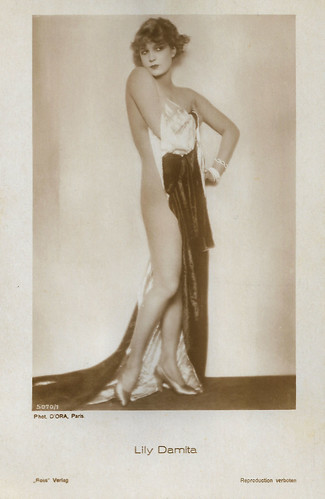
German postcard by Ross-Verlag, Berlin, no. 5070/1, 1930-1931. Photo: d'Ora, Paris.
Beautiful and seductive French actress Lily Damita (1902-1994) appeared in 33 French, Austrian, and Hollywood films between 1922 and 1937. Her marriage with Errol Flynn was rather tempestuous and led to her nickname 'Dynamita'.
Indecent jokes
Dora Philippine Kallmus was born in 1881 in Vienna, Austria. She came from a wealthy Jewish family. Her father Dr. Philipp Kallmus was a respected law attorney. Her mother died early and so she and her sister Anna were brought up by her grandmother and a governess.
Dora's first career aspiration was to become an actress. Because this job was not very well regarded in her family, she decided to become a milliner or tailor. On a trip to France, she discovered photography and decided to become a photographer.
Her family tolerated this plan more than her previous career plans, but there was another obstacle. As a woman, she was not allowed to attend a photography training. At that time women were denied a photography apprenticeship, but Dora Kallmus was allowed to work in the summer studio of the society photographer Hans Makart.
By an exemption, she could also attend the theoretical lectures of the at the Graphische Lehr- und Versuchsanstalt (Graphic Training Institute). However, she was not authorised to visit the practical seminars. Dora Kallmus: “It was found sufficient that I was the first woman to be allowed access to the lectures, but the chemical reagents were kept away from me as if they were indecent jokes.”
In 1905, she became a member of the Association of Austrian photographers. It was through the mediation of her uncle and financial support from her father that she was able to train for a few months in 1907 with the famous photographer Nicola Perscheid in Berlin. Perscheid described her as his "best student so far".
After her internship was over, Perscheid offered to keep her as an employee in his studio, but Dora Kallmus wanted to become self-employed. From then on, Kallmus worked under the pseudonym 'Madame d'Ora'.
She returned to Vienna and founded her own studio, Atelier d'Ora. During her training in Berlin, she had met Arthur Benda, Perscheid's first assistant, and brought him with her to Vienna.
Arthur Benda was born in Berlin in 1885. He worked as an assistant for Nicola Perscheid from 1906 to 1907. Benda became the technical manager of Atelier d'Ora and from 1922 on, they ran the studio together.
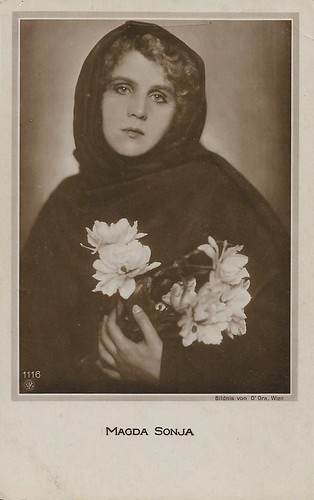
German postcard by NPG (Neue Photographische Geselschaft), no. 1116. Photo: d'Ora, Wien.
Actress Magda Sonja (1895-1974) was one of the divas of the Austrian silent cinema. She often starred in the films of her famous husband, actor and director Friedrich Feher.
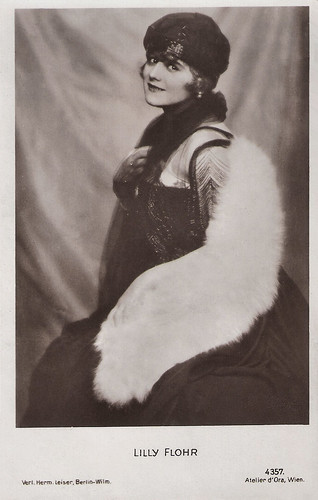
German postcard by Verlag Hermann Leiser, Berlin, no. 4357. Photo: Atelier d'Ora, Wien.
Austrian film star Lilly Flohr (1893-1978) was a busy actress, soubrette, cabaret artist, and chanson singer on stage. From 1918 on she starred in 25 silent films.
[image error]
Austrian postcard by Iris Verlag, no. 804. Photo: d'Ora.
Hungarian Maria Corda (1898-1975) was an immensely popular star of the silent cinema of Austria and Germany. The pretty, blonde actress was a queen of the popular epic spectacles of the 1920s, which were often directed by her husband, Alexander Korda.
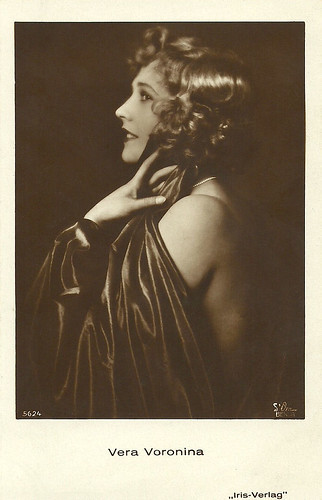
Austrian postcard by Iris Verlag, no. 5624. Photo: d'Ora / Arthur Benda. Collection: Didier Hanson.
Ukrainian actress Vera Voronina (1905-?) had a short but shining career in the late silent era, in Berlin as well as in Hollywood.
No frozen portrait poses
Atelier d’Ora soon gained a foothold in Viennese society. This success was probably partly due to the social ties that Dora Kallmus cultivated. Among the customers were the Austro-Hungarian aristocracy, rich industrialists, and politicians, but also such artists, actors, and writers as Gustav Klimt, Arthur Schnitzler, Marlene Dietrich , Oskar Kokoschka, Anna Sacher, Franz Werfel, and Richard Strauss.
D’Ora quickly was much in demand, especially for its society portraits, fashion photographs, and actor shots. It became chic to be portrayed by d’Ora. With her photographs, Madame d'Ora distinguished herself from the usually frozen portrait poses and looked for new, individual image solutions that matched the portrayed persons.
In addition to being a portrait studio for Viennese society, the Atelier d’Ora was also in high demand for its fashion shots. Designs of the Wiener Werkstätte were also photographed here. Many of the portraits and fashion photographs have been published in newspapers and magazines.
Atelier d’Ora was a commercial photo studio, but Madame d’Ora paid great importance to the artistic demands of her photographs and her studio. She strove for the recognition of her studio as an artistic photo studio. So she tried that to implement principles of pictorial photography and to create images as independent works of art could be viewed.
After the First World War, however, Vienna was no longer the centre of a world power, but only the capital of a small impoverished country. In the summer of 1921, d'Ora and Benda relocated their studio to the fashionable health resort Karlsbad (now Karlovy Vary). There, they worked during the summer months at the Olympic Palace Hotel. From 1921 to 1926 they were very successful there.
Possibly inspired by the French clientele that d’Ora found in Karlovy Vary, she decided to set up a second studio in Paris. In 1925, together with Benda, she opened the Parisian studio in rue Flachard in the 17th arrondissement. But Benda was not able to settle in Paris, their collaboration failed and Benda returned to Vienna.
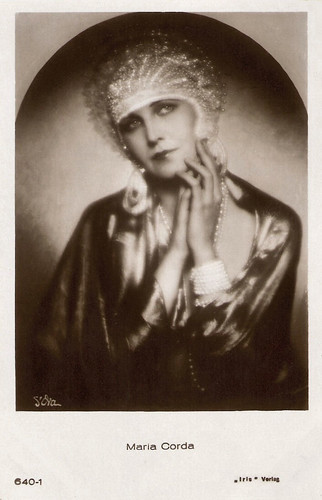
Austrian postcard by Iris Verlag, no. 640-1. Photo: d'Ora.
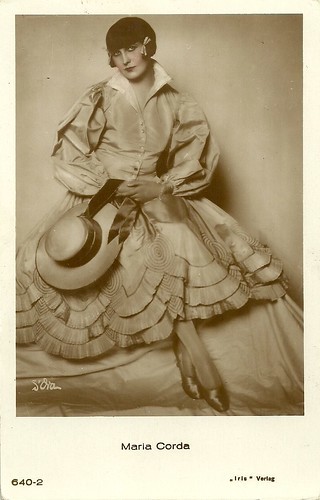
Austrian postcard by Iris Verlag, no. 640-2. Photo d'Ora.
[image error]
German postcard by Ross Verlag, no. 994/3, 1925-1926. Photo: d'Ora, Vienna.
In spite of her French name, Lucy Doraine (1898-1989) was a major Hungarian actress in the Austrian and German cinema in the 1920s. When she moved to Hollywood, the revolution of the sound film finished her career.
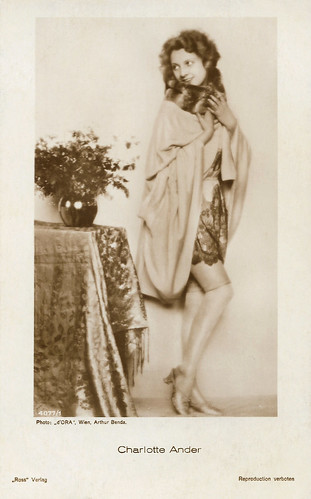
German postcard by Ross Verlag, no. 4077/1, 1929-1930. Photo: d'Ora, Wien / Arthur Benda.
German singer/actress Charlotte Ander (1902-1969) was a star in the silent era before making the transition to sound. The Nazis broke her successful career because she was not of 'pure blood'.
A long, violent legal dispute
In 1927, Madame d’Ora remained in Paris to continue her studio there. Arthur Benda took over the studio in Vienna, replaced d’Ora's share and it came to a long, violent legal dispute over the name of the Vienna studio.
After a long time, it was agreed that Benda had to add his name in Vienna. The studio would now bear the name 'd’Ora-Benda-Vienna' and the Paris studio operated under the name 'd’Ora-Paris'. From the Second World War on, Benda ran the Vienna studio only under his name.
Arthur Benda stayed in Vienna for the rest of his life and became one of the most respected studio photographers and colour technology pioneers. He retired in 1965, and four years later he died of a stroke.
In Paris, Dora Kallmus managed to establish herself a second time and again attracted celebrities for her studio. Among d’Ora's Parisian clientele were again famous dancers, actors, painters, writers, and upper-class ladies. d'Ora portrayed such celebrities as Josephine Baker , Coco Chanel, Anna Pawlowa, Tamara de Lempicka, Alban Berg, Colette , and Maurice Chevalier .
Her photographs changed in terms of the contemporary taste of art and fashion. They became softer and more fluid in the transitions. Carefully elaborated light and glitter effects gave her pictures a glamour effect that was characteristic of this period.
During the Second World War, Dora Kallmus fled to the south of France. After the war, her photographs, her working methods, and their topics changed. In 1945, she travelled to Austria and took photos in a refugee camp where she documented the grief and displacement of the refugees. She reopened her studio in Paris and again made photographs of artists, and did numerous fashion shoots.
Her last significant work is a series of animal carcasses in Paris slaughterhouses from 1956. Kallmus made countless photos of killed, cut, and skinned animal carcasses and documented the consequences of mass slaughter.
After a serious traffic accident in Paris in 1959, Dora Kallmus was no longer able to work. In 1961 she returned to Austria in need of care. At her request, she spent her last years in Frohnleiten in Styria in her family's house. Madame d’Ora died there in 1963.
In the last decade, Madame d'Ora has been rediscovered. Her work was shown in three major exhibitions in Austria: 'Vienna's Shooting Girls – Jüdische Fotografinnen aus Wien' (2012-2013) in the Jewish Museum Vienna, 'Madame d’Ora. Machen Sie mich schön!' (2018) in the Leopold Museum, Vienna, and 'Der große Bruch: d'Oras Spätwerk' (2019-2020) in the GrazMuseum in Graz, Austria.
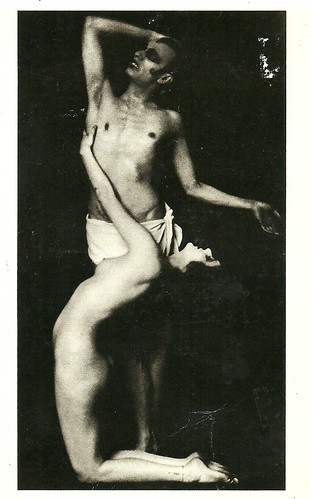
Vintage postcard. Photo: d'Ora, 1923. Collection: Didier Hanson. Photo for 'Dances of Vice, Horror, & Ecstasy' written and danced by Anita Berber and Sebastian Droste.
Expressionistic dancer and film actress Anita Berber (1899–1928) challenged many taboos during the Weimar period. With her drug and booze addiction and her bisexual affairs, she epitomised the decadence of 1920s Berlin. Her charcoaled eyes, her black lipstick, and bright red, bobbed hair were featured on a famous portrait of her by Otto Dix and in silent films by Richard Oswald and Fritz Lang.
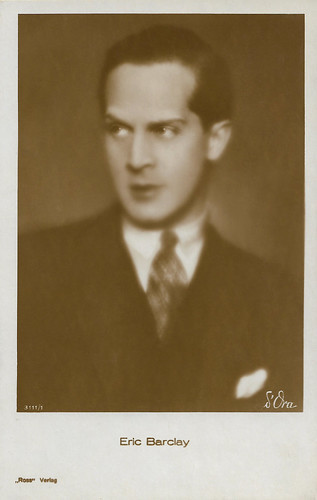
German postcard by Ross Verlag, no. 3111/1, 1928-1929. Photo: d'Ora.
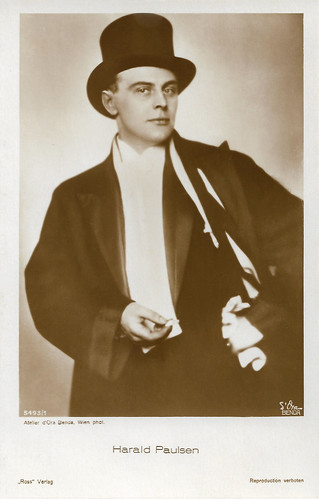
German postcard by Ross Verlag, no. 5493/1, 1930-1931. photo: Atelier d'Ora Benda, Wien.
Fast-talking German actor Harald Paulsen (1895-1954) appeared in 125 films between 1920 and 1954, including Robert Wiene's Genuine (1920) and Alraune (1930) with Brigitte Helm . He was on stage from 1913 and an ensemble member of Max Reinhardt's Deutsche Theater in the 1920s. Paulsen also played Mack the Knife in the original cast of 'Die Dreigroschenoper' (The Threepenny Opera) written by Kurt Weill and Bertolt Brecht. The show's opening number, 'Mack the Knife', became the most popular song of its time.
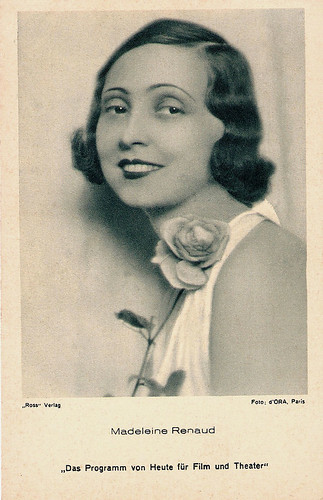
German postcard by Ross Verlag / Das Programm von Heute für Film und Theater. Photo: d'Ora. Paris.
Madeleine Renaud (1900-1994) was an acclaimed French stage actress, who also had a career in film. One of her best-known films was La Maternelle (1933).
Sources: Sophie Dorothée Vitovec (Anita Berber im fotografischen Blick von Madame d’Ora - German), Wikipedia and Luminous Lint.

Small French card by Columbia. Photo: d'Ora.
Josephine Baker (1906-1975) was well-known as a singer and dancer. In 1925 she became an instant success in Paris, because of her erotic dance. She also performed in a handful of silent and early sound films, La Sirene des Tropiques (1927), Zouzou (1934), and La princesse TamTam (1935).

Austrian postcard by Iris Verlag, no. 994. Photo: d'Ora.
Eric Barclay (1894-1938) was a Swedish film actor. Barclay became a prominent actor in French silent films of the early 1920s, often working with director Jacques de Baroncelli. He also appeared in German and British films and those of his native Sweden.

German postcard by Ross Verlag, no. 3264/1, 1928-1929. Photo: d'Ora / Arthur Benda.
Marlene Dietrich (1901-1992) is regarded as the first German actress to become successful in Hollywood. Throughout her long career, she constantly re-invented herself, starting as a cabaret singer, chorus girl and film actress in 1920s Berlin, she became a Hollywood movie star in the 1930s, a World War II frontline entertainer, and finally an international stage show performer from the 1950s to the 1970s, eventually becoming one of the entertainment icons of the 20th century.

German postcard by Ross-Verlag, Berlin, no. 5070/1, 1930-1931. Photo: d'Ora, Paris.
Beautiful and seductive French actress Lily Damita (1902-1994) appeared in 33 French, Austrian, and Hollywood films between 1922 and 1937. Her marriage with Errol Flynn was rather tempestuous and led to her nickname 'Dynamita'.
Indecent jokes
Dora Philippine Kallmus was born in 1881 in Vienna, Austria. She came from a wealthy Jewish family. Her father Dr. Philipp Kallmus was a respected law attorney. Her mother died early and so she and her sister Anna were brought up by her grandmother and a governess.
Dora's first career aspiration was to become an actress. Because this job was not very well regarded in her family, she decided to become a milliner or tailor. On a trip to France, she discovered photography and decided to become a photographer.
Her family tolerated this plan more than her previous career plans, but there was another obstacle. As a woman, she was not allowed to attend a photography training. At that time women were denied a photography apprenticeship, but Dora Kallmus was allowed to work in the summer studio of the society photographer Hans Makart.
By an exemption, she could also attend the theoretical lectures of the at the Graphische Lehr- und Versuchsanstalt (Graphic Training Institute). However, she was not authorised to visit the practical seminars. Dora Kallmus: “It was found sufficient that I was the first woman to be allowed access to the lectures, but the chemical reagents were kept away from me as if they were indecent jokes.”
In 1905, she became a member of the Association of Austrian photographers. It was through the mediation of her uncle and financial support from her father that she was able to train for a few months in 1907 with the famous photographer Nicola Perscheid in Berlin. Perscheid described her as his "best student so far".
After her internship was over, Perscheid offered to keep her as an employee in his studio, but Dora Kallmus wanted to become self-employed. From then on, Kallmus worked under the pseudonym 'Madame d'Ora'.
She returned to Vienna and founded her own studio, Atelier d'Ora. During her training in Berlin, she had met Arthur Benda, Perscheid's first assistant, and brought him with her to Vienna.
Arthur Benda was born in Berlin in 1885. He worked as an assistant for Nicola Perscheid from 1906 to 1907. Benda became the technical manager of Atelier d'Ora and from 1922 on, they ran the studio together.

German postcard by NPG (Neue Photographische Geselschaft), no. 1116. Photo: d'Ora, Wien.
Actress Magda Sonja (1895-1974) was one of the divas of the Austrian silent cinema. She often starred in the films of her famous husband, actor and director Friedrich Feher.

German postcard by Verlag Hermann Leiser, Berlin, no. 4357. Photo: Atelier d'Ora, Wien.
Austrian film star Lilly Flohr (1893-1978) was a busy actress, soubrette, cabaret artist, and chanson singer on stage. From 1918 on she starred in 25 silent films.
[image error]
Austrian postcard by Iris Verlag, no. 804. Photo: d'Ora.
Hungarian Maria Corda (1898-1975) was an immensely popular star of the silent cinema of Austria and Germany. The pretty, blonde actress was a queen of the popular epic spectacles of the 1920s, which were often directed by her husband, Alexander Korda.

Austrian postcard by Iris Verlag, no. 5624. Photo: d'Ora / Arthur Benda. Collection: Didier Hanson.
Ukrainian actress Vera Voronina (1905-?) had a short but shining career in the late silent era, in Berlin as well as in Hollywood.
No frozen portrait poses
Atelier d’Ora soon gained a foothold in Viennese society. This success was probably partly due to the social ties that Dora Kallmus cultivated. Among the customers were the Austro-Hungarian aristocracy, rich industrialists, and politicians, but also such artists, actors, and writers as Gustav Klimt, Arthur Schnitzler, Marlene Dietrich , Oskar Kokoschka, Anna Sacher, Franz Werfel, and Richard Strauss.
D’Ora quickly was much in demand, especially for its society portraits, fashion photographs, and actor shots. It became chic to be portrayed by d’Ora. With her photographs, Madame d'Ora distinguished herself from the usually frozen portrait poses and looked for new, individual image solutions that matched the portrayed persons.
In addition to being a portrait studio for Viennese society, the Atelier d’Ora was also in high demand for its fashion shots. Designs of the Wiener Werkstätte were also photographed here. Many of the portraits and fashion photographs have been published in newspapers and magazines.
Atelier d’Ora was a commercial photo studio, but Madame d’Ora paid great importance to the artistic demands of her photographs and her studio. She strove for the recognition of her studio as an artistic photo studio. So she tried that to implement principles of pictorial photography and to create images as independent works of art could be viewed.
After the First World War, however, Vienna was no longer the centre of a world power, but only the capital of a small impoverished country. In the summer of 1921, d'Ora and Benda relocated their studio to the fashionable health resort Karlsbad (now Karlovy Vary). There, they worked during the summer months at the Olympic Palace Hotel. From 1921 to 1926 they were very successful there.
Possibly inspired by the French clientele that d’Ora found in Karlovy Vary, she decided to set up a second studio in Paris. In 1925, together with Benda, she opened the Parisian studio in rue Flachard in the 17th arrondissement. But Benda was not able to settle in Paris, their collaboration failed and Benda returned to Vienna.

Austrian postcard by Iris Verlag, no. 640-1. Photo: d'Ora.

Austrian postcard by Iris Verlag, no. 640-2. Photo d'Ora.
[image error]
German postcard by Ross Verlag, no. 994/3, 1925-1926. Photo: d'Ora, Vienna.
In spite of her French name, Lucy Doraine (1898-1989) was a major Hungarian actress in the Austrian and German cinema in the 1920s. When she moved to Hollywood, the revolution of the sound film finished her career.

German postcard by Ross Verlag, no. 4077/1, 1929-1930. Photo: d'Ora, Wien / Arthur Benda.
German singer/actress Charlotte Ander (1902-1969) was a star in the silent era before making the transition to sound. The Nazis broke her successful career because she was not of 'pure blood'.
A long, violent legal dispute
In 1927, Madame d’Ora remained in Paris to continue her studio there. Arthur Benda took over the studio in Vienna, replaced d’Ora's share and it came to a long, violent legal dispute over the name of the Vienna studio.
After a long time, it was agreed that Benda had to add his name in Vienna. The studio would now bear the name 'd’Ora-Benda-Vienna' and the Paris studio operated under the name 'd’Ora-Paris'. From the Second World War on, Benda ran the Vienna studio only under his name.
Arthur Benda stayed in Vienna for the rest of his life and became one of the most respected studio photographers and colour technology pioneers. He retired in 1965, and four years later he died of a stroke.
In Paris, Dora Kallmus managed to establish herself a second time and again attracted celebrities for her studio. Among d’Ora's Parisian clientele were again famous dancers, actors, painters, writers, and upper-class ladies. d'Ora portrayed such celebrities as Josephine Baker , Coco Chanel, Anna Pawlowa, Tamara de Lempicka, Alban Berg, Colette , and Maurice Chevalier .
Her photographs changed in terms of the contemporary taste of art and fashion. They became softer and more fluid in the transitions. Carefully elaborated light and glitter effects gave her pictures a glamour effect that was characteristic of this period.
During the Second World War, Dora Kallmus fled to the south of France. After the war, her photographs, her working methods, and their topics changed. In 1945, she travelled to Austria and took photos in a refugee camp where she documented the grief and displacement of the refugees. She reopened her studio in Paris and again made photographs of artists, and did numerous fashion shoots.
Her last significant work is a series of animal carcasses in Paris slaughterhouses from 1956. Kallmus made countless photos of killed, cut, and skinned animal carcasses and documented the consequences of mass slaughter.
After a serious traffic accident in Paris in 1959, Dora Kallmus was no longer able to work. In 1961 she returned to Austria in need of care. At her request, she spent her last years in Frohnleiten in Styria in her family's house. Madame d’Ora died there in 1963.
In the last decade, Madame d'Ora has been rediscovered. Her work was shown in three major exhibitions in Austria: 'Vienna's Shooting Girls – Jüdische Fotografinnen aus Wien' (2012-2013) in the Jewish Museum Vienna, 'Madame d’Ora. Machen Sie mich schön!' (2018) in the Leopold Museum, Vienna, and 'Der große Bruch: d'Oras Spätwerk' (2019-2020) in the GrazMuseum in Graz, Austria.

Vintage postcard. Photo: d'Ora, 1923. Collection: Didier Hanson. Photo for 'Dances of Vice, Horror, & Ecstasy' written and danced by Anita Berber and Sebastian Droste.
Expressionistic dancer and film actress Anita Berber (1899–1928) challenged many taboos during the Weimar period. With her drug and booze addiction and her bisexual affairs, she epitomised the decadence of 1920s Berlin. Her charcoaled eyes, her black lipstick, and bright red, bobbed hair were featured on a famous portrait of her by Otto Dix and in silent films by Richard Oswald and Fritz Lang.

German postcard by Ross Verlag, no. 3111/1, 1928-1929. Photo: d'Ora.

German postcard by Ross Verlag, no. 5493/1, 1930-1931. photo: Atelier d'Ora Benda, Wien.
Fast-talking German actor Harald Paulsen (1895-1954) appeared in 125 films between 1920 and 1954, including Robert Wiene's Genuine (1920) and Alraune (1930) with Brigitte Helm . He was on stage from 1913 and an ensemble member of Max Reinhardt's Deutsche Theater in the 1920s. Paulsen also played Mack the Knife in the original cast of 'Die Dreigroschenoper' (The Threepenny Opera) written by Kurt Weill and Bertolt Brecht. The show's opening number, 'Mack the Knife', became the most popular song of its time.

German postcard by Ross Verlag / Das Programm von Heute für Film und Theater. Photo: d'Ora. Paris.
Madeleine Renaud (1900-1994) was an acclaimed French stage actress, who also had a career in film. One of her best-known films was La Maternelle (1933).
Sources: Sophie Dorothée Vitovec (Anita Berber im fotografischen Blick von Madame d’Ora - German), Wikipedia and Luminous Lint.
Published on June 03, 2020 22:00
June 2, 2020
Marte Harell
Austrian actress Marte Harell (1907-1996) played strong women who determined the events, in several Viennese comedies and operettas of the 1940s and 1950s.
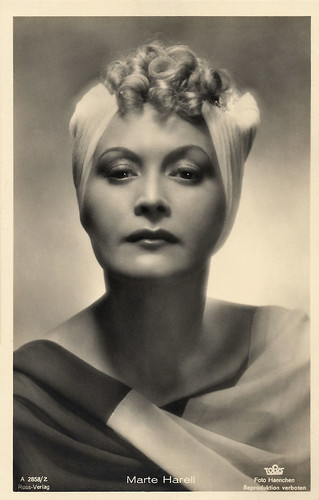
German postcard by Ross Verlag, no. A 2858/2, 1939-1940. Photo: Haenchen / Tobis.
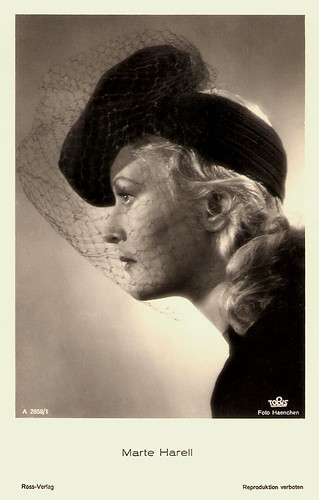
German postcard by Ross Verlag, no. A 2859/1, 1939-1940. Photo: Haenchen / Tobis.
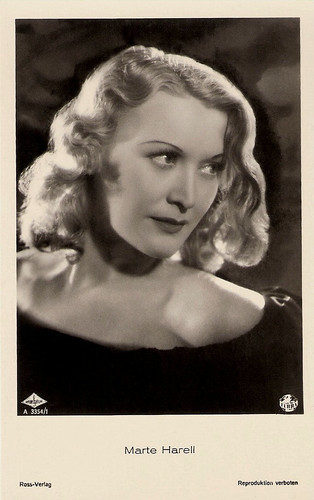
German postcard by Ross Verlag, no. A 3354/1, 1941-1944. Photo: Wien Film / Terra.
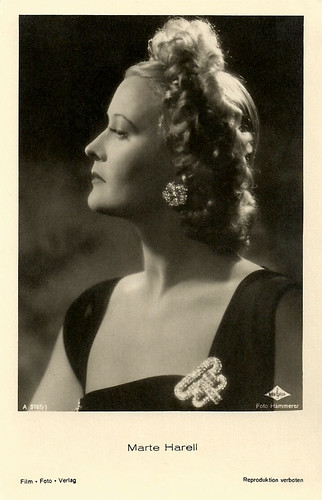
German postcard by Film-Foto-Verlag, no. A 3765/1, 1941-1944. Photo: Hämmerer / Wien Film.
Wiener Mädel
Marte Harell was born as Martha Schömig in Wien (Vienna), Austria-Hungary, now Austria in 1907. She was the daughter of architect Rudolf Schömig and his wife Emilie Mathilde Passetzky.
Marte visited a secondary school for girls in Vienna. Her acting career started when she married director Karl Hartl in 1930. She followed acting classes from Margit von Tolnai and attended the Max-Reinhardt-Seminar.
At 30, she made her debut at the Kammerspielen des Theaters in der Josefstadt. She worked for theatres in Munich and Berlin, where she was spotted by director Géza von Bolváry at the Deutsches Theater. He asked her for the leading lady tole in his film Opernball/Opera Ball (Géza von Bolváry, 1939) opposite Paul Hörbiger .
Her film debut at 32 as the typical 'Wiener mädel' (Viennese girl) became an unexpected success. More leading roles followed in Wiener G'schichten/Vienna Tales (Géza von Bolváry, 1940) again opposite Paul Hörbiger , and an adaption of the Carl Zeller operetta 'Der Vogelhändler', Rosen in Tirol/The Bird Seller (Géza von Bolváry, 1940) with Johannes Heesters.
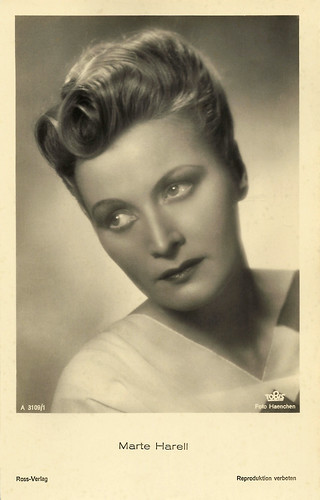
German postcard by Ross Verlag, no. A 3109/1, 1941-1944. Photo: Haenchen / Tobis.
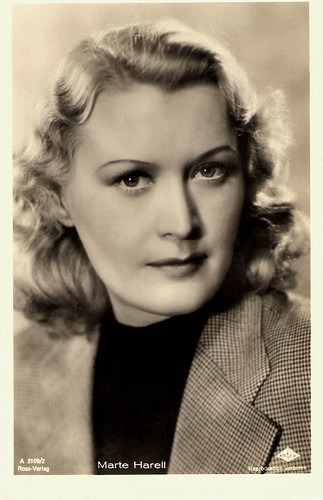
German postcard by Ross Verlag, no. A 3109/2, 1941-1944. Photo: Wien-Film.
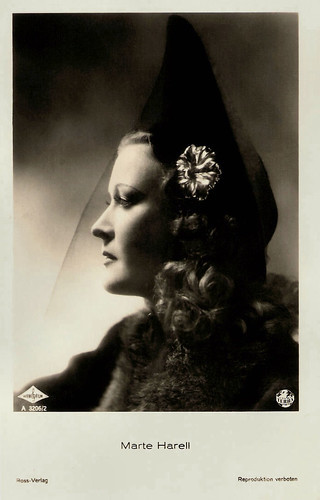
German postcard by Ross Verlag, no. A 3206/2, 1941-1944. Photo: Wien Film / Terra.
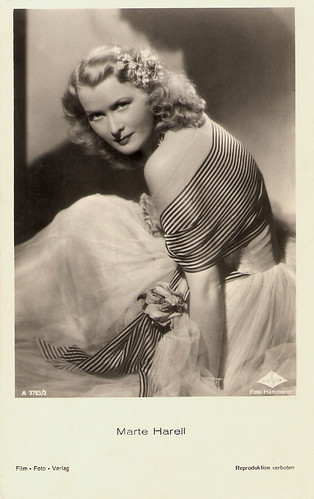
German postcard by Film-Foto-Verlag, no. A 3765/2, 1941-1944. Photo: Hämmerer / Wien-Film.

German postcard by Film-Foto-Verlag, no. A 3934/1, 1941-1944. Photo: Hämmerer / Wien-Film.
Not a Hollywood-style Glamourpuss
Marte Harell became very busy as an actress for the new founded Wien-Film, when her husband, Karl Hartl, became the production manager of this company.
She convinced critics and audiences with her performances in Brüderlein fein/Dear Brother (Hans Thimig, 1941), the comedy Die heimliche Gräfin/The Secret Countess (Géza von Bolváry, 1942) with Wolf Albach-Retty , Frauen sind keine Engel/Women Are No Angels (Willi Forst, 1943) with a young Curd Jürgens , and Tolle Nacht/Great Night (Theo Lingen, 1943).
She always played the strong woman who determined the events and was not able to hide her typical Viennese accent. The part of Fiakermilli (Cabby Milli) in the beautiful tragi-comedy-musical Schrammeln (Géza von Bolváry, 1944) was her most popular role.
For the adaptation of Johann Strauss' comic opera Die Fledermaus/The Bat (1945), she worked again with director Géza von Bolváry, with whom she would make a total of ten films.
Harell continued her film career immediately after the Second World War with Glaube an mich/Believe in Me (Géza von Cziffra, 1946), but the film was torn to pieces by the critics. Two years later she returned in the romance Nach dem Sturm/After the Storm (Gustav Ucicky, 1948), based on a story by Carl Zuckmeyer.
Wien Tanzt/Vienna Waltzes (Emil E. Reinert, 1951) was an old-fashioned musical extravaganza in the tradition of the pre-war Austrian films. The story centers upon Waltz King Johann Strauss ( Adolf Wohlbrück ) and his ‘progressive’ composer son Richard, and their terrific music.
About the female lead, Hal Erickson writes at AllMovie : “The feminine interest in Wien Tanzt is provided by Marte Harell, who refreshingly is not a Hollywood-style glamourpuss.”
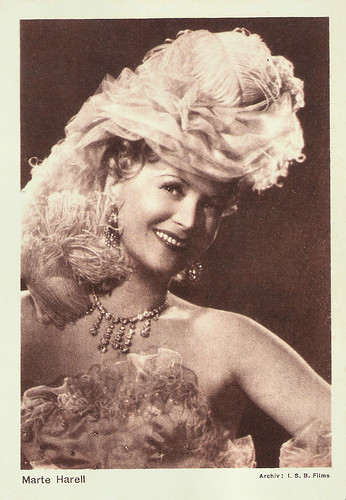
Austrian postcard by Eberle Verlag, Wien, no. 21. Photo: I.S.B. Films.

German postcard by Film-Foto-Verlag, no. G 141, 1941-1944. Photo: Hämmerer / Wien-Film.
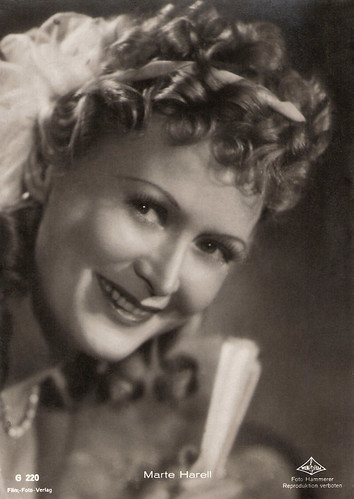
German postcard by Film-Foto-Verlag, no. G 220, 1941-1944. Photo: Hämmerer / Wien-Film.
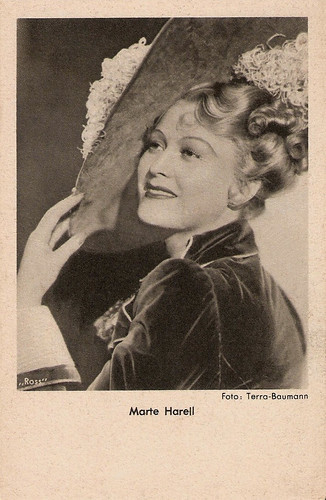
German postcard by Ross. Photo: Terra / Baumann.
Most Popular Actress
In 1951, the Austrian public chose Marte Harell as the most popular actress, but her film roles became rarer during the 1950s. In between, she had a successful stage comeback and dedicated herself again to the theatre.
She appeared in one film a year, among others the comedy Liebeskrieg nach Noten/Love War for Music (Karl Hartl, 1953) with Johannes Heesters , the historical thriller Spionage/Espionage (Franz Antel, 1955) based on the tragic life story of the homosexual ‘Oberst’ Alfred Redl, and the operetta Im Prater blühn wieder die Bäume/Trees Are Blooming in Vienna (Hans Wolff, 1958).
Her last films were the spy yarn Assignment K (Val Guest, 1968) starring Stephen Boyd , Abenteuer eines Sommers/Summer Adventure (Helmut Pfandler, 1974) starring Matthias Habich, the sex comedy Das Love-Hotel in Tirol/Love Hotel in Tyrol (Franz Antel, 1978), and the historical drama Der Bockerer (Franz Antel, 1980), about the naïve Viennese butcher Karl Bockerer who refuses to get assimilated by the Nazi system and with his aggressive but charming behaviour, and a whole lot of luck, survives the war.
During the 1970s, Marte Harell also worked regularly for television and made guest appearances in series like Hallo – Hotel Sacher… Portier!/Hello – Hotel Sacher… Doorman! (1973), Van der Valk und die Reichen/Van der Valk and the Rich (1975), and the popular Krimi Tatort (1974).
In 1985, she was awarded the Filmband in Gold for her longtime and important attributions to the German cinema, and that same year she retired.
In 1996, Marte Harell died in Vienna. Her husband, Karl Hartl, had passed away in 1978. In 1951 the couple was divorced, but eight years later they remarried. In 2000 a street was named after her, the Marte-Harell-Gasse in Wien-Liesing.
Scene with Heli Finkenzeller, Theo Lingen and Marte Harell from Opernball/Opera Ball (1939). Source: BD130 (YouTube).
Clips with Marte Harell, Willy Fritsch and Johannes Heesters from Die Fledermaus/The Bat (1944). Source: Fritz 5108 (YouTube).
Another, long scene from Die Fledermaus/The Bat (1944-1945, but released in 1946), with Dorit Kreysler , Hans Brausewetter , Johannes Heesters , Marte Harell, Siegfried Breuer , Will Dohm , and Willy Fritsch . Source: Atqui (YouTube).
The final scene from Rosen in Tirol/The Bird Seller (1940) with Marte Harell, Johannes Heesters and Hans Moser . Source: Ein Lied Geht um die Welt (YouTube).
Sources: Thomas Staedeli (Cyranos), Hal Erickson (AllMovie), Stephanie D’heil (Steffi-Line - German), Wikipedia (German) and .

German postcard by Ross Verlag, no. A 2858/2, 1939-1940. Photo: Haenchen / Tobis.

German postcard by Ross Verlag, no. A 2859/1, 1939-1940. Photo: Haenchen / Tobis.

German postcard by Ross Verlag, no. A 3354/1, 1941-1944. Photo: Wien Film / Terra.

German postcard by Film-Foto-Verlag, no. A 3765/1, 1941-1944. Photo: Hämmerer / Wien Film.
Wiener Mädel
Marte Harell was born as Martha Schömig in Wien (Vienna), Austria-Hungary, now Austria in 1907. She was the daughter of architect Rudolf Schömig and his wife Emilie Mathilde Passetzky.
Marte visited a secondary school for girls in Vienna. Her acting career started when she married director Karl Hartl in 1930. She followed acting classes from Margit von Tolnai and attended the Max-Reinhardt-Seminar.
At 30, she made her debut at the Kammerspielen des Theaters in der Josefstadt. She worked for theatres in Munich and Berlin, where she was spotted by director Géza von Bolváry at the Deutsches Theater. He asked her for the leading lady tole in his film Opernball/Opera Ball (Géza von Bolváry, 1939) opposite Paul Hörbiger .
Her film debut at 32 as the typical 'Wiener mädel' (Viennese girl) became an unexpected success. More leading roles followed in Wiener G'schichten/Vienna Tales (Géza von Bolváry, 1940) again opposite Paul Hörbiger , and an adaption of the Carl Zeller operetta 'Der Vogelhändler', Rosen in Tirol/The Bird Seller (Géza von Bolváry, 1940) with Johannes Heesters.

German postcard by Ross Verlag, no. A 3109/1, 1941-1944. Photo: Haenchen / Tobis.

German postcard by Ross Verlag, no. A 3109/2, 1941-1944. Photo: Wien-Film.

German postcard by Ross Verlag, no. A 3206/2, 1941-1944. Photo: Wien Film / Terra.

German postcard by Film-Foto-Verlag, no. A 3765/2, 1941-1944. Photo: Hämmerer / Wien-Film.

German postcard by Film-Foto-Verlag, no. A 3934/1, 1941-1944. Photo: Hämmerer / Wien-Film.
Not a Hollywood-style Glamourpuss
Marte Harell became very busy as an actress for the new founded Wien-Film, when her husband, Karl Hartl, became the production manager of this company.
She convinced critics and audiences with her performances in Brüderlein fein/Dear Brother (Hans Thimig, 1941), the comedy Die heimliche Gräfin/The Secret Countess (Géza von Bolváry, 1942) with Wolf Albach-Retty , Frauen sind keine Engel/Women Are No Angels (Willi Forst, 1943) with a young Curd Jürgens , and Tolle Nacht/Great Night (Theo Lingen, 1943).
She always played the strong woman who determined the events and was not able to hide her typical Viennese accent. The part of Fiakermilli (Cabby Milli) in the beautiful tragi-comedy-musical Schrammeln (Géza von Bolváry, 1944) was her most popular role.
For the adaptation of Johann Strauss' comic opera Die Fledermaus/The Bat (1945), she worked again with director Géza von Bolváry, with whom she would make a total of ten films.
Harell continued her film career immediately after the Second World War with Glaube an mich/Believe in Me (Géza von Cziffra, 1946), but the film was torn to pieces by the critics. Two years later she returned in the romance Nach dem Sturm/After the Storm (Gustav Ucicky, 1948), based on a story by Carl Zuckmeyer.
Wien Tanzt/Vienna Waltzes (Emil E. Reinert, 1951) was an old-fashioned musical extravaganza in the tradition of the pre-war Austrian films. The story centers upon Waltz King Johann Strauss ( Adolf Wohlbrück ) and his ‘progressive’ composer son Richard, and their terrific music.
About the female lead, Hal Erickson writes at AllMovie : “The feminine interest in Wien Tanzt is provided by Marte Harell, who refreshingly is not a Hollywood-style glamourpuss.”

Austrian postcard by Eberle Verlag, Wien, no. 21. Photo: I.S.B. Films.

German postcard by Film-Foto-Verlag, no. G 141, 1941-1944. Photo: Hämmerer / Wien-Film.

German postcard by Film-Foto-Verlag, no. G 220, 1941-1944. Photo: Hämmerer / Wien-Film.

German postcard by Ross. Photo: Terra / Baumann.
Most Popular Actress
In 1951, the Austrian public chose Marte Harell as the most popular actress, but her film roles became rarer during the 1950s. In between, she had a successful stage comeback and dedicated herself again to the theatre.
She appeared in one film a year, among others the comedy Liebeskrieg nach Noten/Love War for Music (Karl Hartl, 1953) with Johannes Heesters , the historical thriller Spionage/Espionage (Franz Antel, 1955) based on the tragic life story of the homosexual ‘Oberst’ Alfred Redl, and the operetta Im Prater blühn wieder die Bäume/Trees Are Blooming in Vienna (Hans Wolff, 1958).
Her last films were the spy yarn Assignment K (Val Guest, 1968) starring Stephen Boyd , Abenteuer eines Sommers/Summer Adventure (Helmut Pfandler, 1974) starring Matthias Habich, the sex comedy Das Love-Hotel in Tirol/Love Hotel in Tyrol (Franz Antel, 1978), and the historical drama Der Bockerer (Franz Antel, 1980), about the naïve Viennese butcher Karl Bockerer who refuses to get assimilated by the Nazi system and with his aggressive but charming behaviour, and a whole lot of luck, survives the war.
During the 1970s, Marte Harell also worked regularly for television and made guest appearances in series like Hallo – Hotel Sacher… Portier!/Hello – Hotel Sacher… Doorman! (1973), Van der Valk und die Reichen/Van der Valk and the Rich (1975), and the popular Krimi Tatort (1974).
In 1985, she was awarded the Filmband in Gold for her longtime and important attributions to the German cinema, and that same year she retired.
In 1996, Marte Harell died in Vienna. Her husband, Karl Hartl, had passed away in 1978. In 1951 the couple was divorced, but eight years later they remarried. In 2000 a street was named after her, the Marte-Harell-Gasse in Wien-Liesing.
Scene with Heli Finkenzeller, Theo Lingen and Marte Harell from Opernball/Opera Ball (1939). Source: BD130 (YouTube).
Clips with Marte Harell, Willy Fritsch and Johannes Heesters from Die Fledermaus/The Bat (1944). Source: Fritz 5108 (YouTube).
Another, long scene from Die Fledermaus/The Bat (1944-1945, but released in 1946), with Dorit Kreysler , Hans Brausewetter , Johannes Heesters , Marte Harell, Siegfried Breuer , Will Dohm , and Willy Fritsch . Source: Atqui (YouTube).
The final scene from Rosen in Tirol/The Bird Seller (1940) with Marte Harell, Johannes Heesters and Hans Moser . Source: Ein Lied Geht um die Welt (YouTube).
Sources: Thomas Staedeli (Cyranos), Hal Erickson (AllMovie), Stephanie D’heil (Steffi-Line - German), Wikipedia (German) and .
Published on June 02, 2020 22:00
June 1, 2020
Gräfin Donelli (1924)
Gräfin Donelli/Countess Donelli (1924) was a typical Henny Porten film of the 1920s, a rather conventional melodrama. Porten's handsome co-star was the little-known Eberhard Leithoff. Remarkable is the director. Gräfin Donelli is the second film of Georg Wilhelm Pabst, one of the most influential German-language filmmakers during the Weimar Republic.

German postcard by Ross Verlag, Berlin, no. 695/1. Photo: Maxim Film. Henny Porten and Friedrich Kayssler in Gräfin Donelli (G.W. Pabst, 1924).

German postcard by Ross Verlag, Berlin, no. 695/2. Photo: Maxim Film. Henny Porten and Eberhard Leithoff in Gräfin Donelli (G.W. Pabst, 1924).
An act of desperation
In Gräfin Donelli (1924), Henny Porten stars as Countess Mathilde Donelli who has become a widow early on, as her unfaithful husband killed himself.
Now she is in material need. Her uncle, the much older Count Bergheim ( Friedrich Kayssler ), shows interest in Mathilde, but she is much more interested in Bergheim's handsome secretary Hellwig (Eberhard Leithoff).
To help Mathilde, Hellwig sends Countess Donelli a larger sum of money. Thereupon the countess's uncle accuses his secretary of the theft because he wants to crush the young happiness.
Graf Bergheim is prepared to waive a criminal complaint should Hellwig stay away from Mathilde from now on. Countess Donelli then lets herself be carried out to an act of desperation and shoots him down. The doctors can save the wounded man.
Countess Donelli marries her great love after his recovery. Years later, Count Bergheim realises that he would never have a chance with Mathilde and admits that he staged the embezzlement. Now Hellwig is finally rehabilitated.
Gräfin Donelli (1924) was a production by Maxim Film and Ebner & Co. The script was written by Hans Kyser. The cinematographer was Guido Seeber, and the sets were designed by art director Herman Warm. The co-director and editor was Mark Sorkin. G. W. Pabst would later often work again with them in his films.
Pabst's best-known silent films concern the plight of women, including Die freudlose Gasse/The Joyless Street (1925) with Greta Garbo and Asta Nielsen , Geheimnisse einer Seele/Secrets of a Soul (1926) with Lily Damita , Die Liebe der Jeanne Ney/The Loves of Jeanne Ney (1927) with Brigitte Helm , Die Büchse der Pandora/Pandora's Box (1929), and Tagebuch einer Verlorenen/Diary of a Lost Girl (1929) with American actress Louise Brooks . He also co-directed with Arnold Fanck the Bergfilm (mountain film) Die weiße Hölle vom Piz Palü/The White Hell of Pitz Palu (1929) starring Leni Riefenstahl .
Gräfin Donelli passed censorship on 28 August 1924 and premiered on 7 November 1924 at the Primus-Palast in Berlin. The film is now believed to be lost.
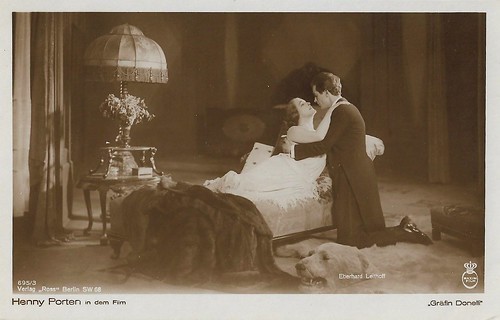
German postcard by Ross Verlag, Berlin, no. 695/3. Photo: Maxim Film. Henny Porten and Eberhard Leithoff in Gräfin Donelli (G.W. Pabst, 1924).

German postcard by Ross Verlag, Berlin, no. 695/4. Photo: Maxim Film. Henny Porten , Ferdinand von Alten, and Friedrich Kayssler in Gräfin Donelli (G.W. Pabst, 1924). Von Alten played Baron von Trachwitz.
Source: Wikipedia (German and English), and IMDb.

German postcard by Ross Verlag, Berlin, no. 695/1. Photo: Maxim Film. Henny Porten and Friedrich Kayssler in Gräfin Donelli (G.W. Pabst, 1924).

German postcard by Ross Verlag, Berlin, no. 695/2. Photo: Maxim Film. Henny Porten and Eberhard Leithoff in Gräfin Donelli (G.W. Pabst, 1924).
An act of desperation
In Gräfin Donelli (1924), Henny Porten stars as Countess Mathilde Donelli who has become a widow early on, as her unfaithful husband killed himself.
Now she is in material need. Her uncle, the much older Count Bergheim ( Friedrich Kayssler ), shows interest in Mathilde, but she is much more interested in Bergheim's handsome secretary Hellwig (Eberhard Leithoff).
To help Mathilde, Hellwig sends Countess Donelli a larger sum of money. Thereupon the countess's uncle accuses his secretary of the theft because he wants to crush the young happiness.
Graf Bergheim is prepared to waive a criminal complaint should Hellwig stay away from Mathilde from now on. Countess Donelli then lets herself be carried out to an act of desperation and shoots him down. The doctors can save the wounded man.
Countess Donelli marries her great love after his recovery. Years later, Count Bergheim realises that he would never have a chance with Mathilde and admits that he staged the embezzlement. Now Hellwig is finally rehabilitated.
Gräfin Donelli (1924) was a production by Maxim Film and Ebner & Co. The script was written by Hans Kyser. The cinematographer was Guido Seeber, and the sets were designed by art director Herman Warm. The co-director and editor was Mark Sorkin. G. W. Pabst would later often work again with them in his films.
Pabst's best-known silent films concern the plight of women, including Die freudlose Gasse/The Joyless Street (1925) with Greta Garbo and Asta Nielsen , Geheimnisse einer Seele/Secrets of a Soul (1926) with Lily Damita , Die Liebe der Jeanne Ney/The Loves of Jeanne Ney (1927) with Brigitte Helm , Die Büchse der Pandora/Pandora's Box (1929), and Tagebuch einer Verlorenen/Diary of a Lost Girl (1929) with American actress Louise Brooks . He also co-directed with Arnold Fanck the Bergfilm (mountain film) Die weiße Hölle vom Piz Palü/The White Hell of Pitz Palu (1929) starring Leni Riefenstahl .
Gräfin Donelli passed censorship on 28 August 1924 and premiered on 7 November 1924 at the Primus-Palast in Berlin. The film is now believed to be lost.

German postcard by Ross Verlag, Berlin, no. 695/3. Photo: Maxim Film. Henny Porten and Eberhard Leithoff in Gräfin Donelli (G.W. Pabst, 1924).

German postcard by Ross Verlag, Berlin, no. 695/4. Photo: Maxim Film. Henny Porten , Ferdinand von Alten, and Friedrich Kayssler in Gräfin Donelli (G.W. Pabst, 1924). Von Alten played Baron von Trachwitz.
Source: Wikipedia (German and English), and IMDb.
Published on June 01, 2020 22:00
May 31, 2020
André Deed
André Deed (1879-1940) was one of the most popular comedians in French and Italian silent cinema. He was one of the first of the named actors in the cinema, and his film series based around Boireau and Cretinetti aka Foolshead were a global success. He also worked as a film director and scriptwriter.

French postcard by Edition Pathé Frères. Photo: X.

French postcard by Théâtre Pathé Grolée, Lyon. Photo: Pathé Frères. André Deed in Le fils du diable/The Devil's Son (Charles Lucien Lépine, 1906), with cinematography by Segundo De Chomon.
Foolshead
André Deed was born Henri André Augustin Chapais in Le Havre, France in 1879. He was the son of a customs official. The family moved to Nice when Henri André was young.
He attended lycée in Nice while acting with a small theatre company. Around 1900, he started his career as a circus acrobat and then became a singer in vaudeville theatre and cabaret, including at the Folies Bergères.
In 1901 he did his first steps in the film world for film pioneer Georges Méliès. He played a Pierrot in the short comic fantasy Dislocation mystérieus/An Extraordinary Dislocation (Georges Méliès, 1901). Several body parts of a dancing clown float away from his body and come back again.
In 1906 Deed started at Pathé Frères his own series of short comedies around Boireau, a comic character designed by himself. Among them are comedies like La course à la perruque/The Wig Chase (Georges Hatot, André Heuzé, 1906) with Léon Mathot , Boireau déménage/Foolshead Moved (Georges Hatot, 1906), and Les débuts d'un chauffeur/The Inexperienced Chauffeur (Georges Hatot, 1906).
Between 1906 and 1908, Deed made some 27 films for Pathé, directed by pioneer filmmakers like Georges Hatot and Georges Monca, though of several films the director is not known.
Because of the huge popularity of the Boireau comedies, the Torinese company Itala Film lured Deed to Italy in 1908. There Deed started the series of Cretinetti (which can be translated as ‘little stupid’). He not only acted but also directed his own films now. Just like in the French films, Deed behaved in a quite anarchic way, creating destruction and pursuits all over.
Between 1909 and 1911 and between 1915 and 1920, Deed interpreted Cretinetti in some 90 shorts. A highlight is the absurdist Cretinetti e le donne/Cretinetti and the Women (André Deed, 1910), in which fanatic women tear the man to pieces. In the end, all his loose limbs gather again.
At the time, Deed was after Max Linder the most popular film comedian of the European cinema. His Boireau and Cretinetti characters were even famous all over the world world, although under different names. He was known as Foolshead in English, Müller in German, Toribio in Spanish, Turíbio in Portuguese, Lehmann in Hungary, Glupyuskin in Russia, and so on.
The silent film stars Emilio Ghione and Alberto Collo started their careers in Deed’s films at Itala. He also met his future wife Valentina Frascaroli there. She would perform in many of his films.

Valentina Frascaroli. French postcard. Photo: Pathé.
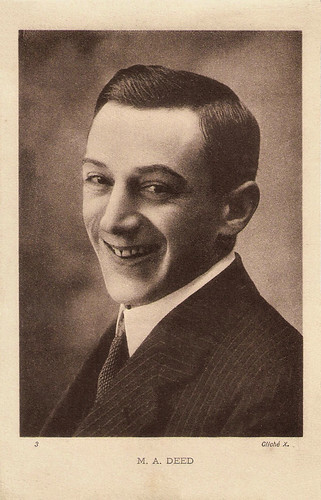
French postcard, no. 3. Cliché X.
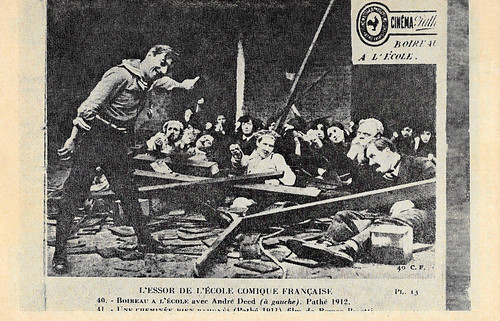
French postcard by Sadag de France, Imp., Paris, no. 40. Photo: Pathé Frères. André Deed in Boireau à l'école/Boireau at school (André Deed, 1912).
Nightwatch in the Pathé Studios
In 1912 André Deed went back to Pathé to perform as Boireau again. Cretinetti was named Gribouille in France, and so his first film for Pathé was entitled Comment Gribouille redevient Boireau/How Gribouille became Boireau again (André Deed, 1912). Valentina Frascaroli collaborated under the character name of Gribouillette.
From 1912 on Deed would make some 70 new shorts as Boireau. In 1913 Deed and Frascaroli did a big European and Latin American theatrical tour. When the First World War broke out in 1914, Deed was drafted first, but in 1915 Itala producer Giovanni Pastrone called him back to Italy. There he directed and played in the war propaganda film La paura degli aereomobili nemici/The fear for Zeppelins (André Deed, 1915) with Domenico Gambino , and Cretinetti e gli stivali del brasilero/Cretinetti and the Brazilian's boots (André Deed, 1916), which had Bartolomeo Pagano alias Maciste in a supporting part as a police officer, plus special effects by Segundo De Chomon.
Afterward, Deed returned to France where he served in various sections of the army, though it is unknown whether he fought in the trenches. In 1918 he married Frascaroli and in 1919 he was demobilised.
In 1920-1921 Deed started a trilogy of Italian fantasy-adventure-films: Il documento umano/The human document (André Deed, 1920), L’uomo meccanico/The Mechanical Man (André Deed, 1921) and Lo strano amore di Mado/The Strange Love of Mado.
L’uomo meccanico was regarded as lost, but some reels of the Portuguese release version were discovered in Brazil. The discovered film amounted to 740 meters which is believed to be approximately 40% of the complete film. This was restored by the Cineteca Comunale di Bologna. L’uomo meccanico/The Mechanical Man is about an indestructible robot which in the end only creates havoc. At the end of the film, there is a spectacular scene with a battle of the two robots in the Opera House.
The latter film of the trilogy, Lo strano amore di Mado/The Strange Love of Mado, was never realised. The popularity of Deed had diminished and new comedians like Charlie Chaplin had taken his place. Deed returned to France, where he still acted in films. In the early sound era, he only could find minor parts.
By the late 1930s, Deed was forgotten by the industry that he helped to launch. He worked as a nightwatch at the Pathé studios, located in the Parisian suburb of Joinville-le-Pont.
Broke and forgotten, André Deed died in 1940 in Paris. He was 61. His wife Valentina Frascaroli passed away in 1955.
André Deed as Cretinetti in Le delizie della caccia/The Delights of Hunting (André Deed, 1910). Source: YasHY2804 (YouTube).
Scene from L’uomo meccanico/The Mechanical Man (André Deed, 1921). Source: JH Banner (YouTube).
Sources: Ivo Blom (All the Same or Strategies of Difference: Early Italian Comedy in International Perspective), Wikipedia (Italian, French and English), and .

French postcard by Edition Pathé Frères. Photo: X.

French postcard by Théâtre Pathé Grolée, Lyon. Photo: Pathé Frères. André Deed in Le fils du diable/The Devil's Son (Charles Lucien Lépine, 1906), with cinematography by Segundo De Chomon.
Foolshead
André Deed was born Henri André Augustin Chapais in Le Havre, France in 1879. He was the son of a customs official. The family moved to Nice when Henri André was young.
He attended lycée in Nice while acting with a small theatre company. Around 1900, he started his career as a circus acrobat and then became a singer in vaudeville theatre and cabaret, including at the Folies Bergères.
In 1901 he did his first steps in the film world for film pioneer Georges Méliès. He played a Pierrot in the short comic fantasy Dislocation mystérieus/An Extraordinary Dislocation (Georges Méliès, 1901). Several body parts of a dancing clown float away from his body and come back again.
In 1906 Deed started at Pathé Frères his own series of short comedies around Boireau, a comic character designed by himself. Among them are comedies like La course à la perruque/The Wig Chase (Georges Hatot, André Heuzé, 1906) with Léon Mathot , Boireau déménage/Foolshead Moved (Georges Hatot, 1906), and Les débuts d'un chauffeur/The Inexperienced Chauffeur (Georges Hatot, 1906).
Between 1906 and 1908, Deed made some 27 films for Pathé, directed by pioneer filmmakers like Georges Hatot and Georges Monca, though of several films the director is not known.
Because of the huge popularity of the Boireau comedies, the Torinese company Itala Film lured Deed to Italy in 1908. There Deed started the series of Cretinetti (which can be translated as ‘little stupid’). He not only acted but also directed his own films now. Just like in the French films, Deed behaved in a quite anarchic way, creating destruction and pursuits all over.
Between 1909 and 1911 and between 1915 and 1920, Deed interpreted Cretinetti in some 90 shorts. A highlight is the absurdist Cretinetti e le donne/Cretinetti and the Women (André Deed, 1910), in which fanatic women tear the man to pieces. In the end, all his loose limbs gather again.
At the time, Deed was after Max Linder the most popular film comedian of the European cinema. His Boireau and Cretinetti characters were even famous all over the world world, although under different names. He was known as Foolshead in English, Müller in German, Toribio in Spanish, Turíbio in Portuguese, Lehmann in Hungary, Glupyuskin in Russia, and so on.
The silent film stars Emilio Ghione and Alberto Collo started their careers in Deed’s films at Itala. He also met his future wife Valentina Frascaroli there. She would perform in many of his films.

Valentina Frascaroli. French postcard. Photo: Pathé.

French postcard, no. 3. Cliché X.

French postcard by Sadag de France, Imp., Paris, no. 40. Photo: Pathé Frères. André Deed in Boireau à l'école/Boireau at school (André Deed, 1912).
Nightwatch in the Pathé Studios
In 1912 André Deed went back to Pathé to perform as Boireau again. Cretinetti was named Gribouille in France, and so his first film for Pathé was entitled Comment Gribouille redevient Boireau/How Gribouille became Boireau again (André Deed, 1912). Valentina Frascaroli collaborated under the character name of Gribouillette.
From 1912 on Deed would make some 70 new shorts as Boireau. In 1913 Deed and Frascaroli did a big European and Latin American theatrical tour. When the First World War broke out in 1914, Deed was drafted first, but in 1915 Itala producer Giovanni Pastrone called him back to Italy. There he directed and played in the war propaganda film La paura degli aereomobili nemici/The fear for Zeppelins (André Deed, 1915) with Domenico Gambino , and Cretinetti e gli stivali del brasilero/Cretinetti and the Brazilian's boots (André Deed, 1916), which had Bartolomeo Pagano alias Maciste in a supporting part as a police officer, plus special effects by Segundo De Chomon.
Afterward, Deed returned to France where he served in various sections of the army, though it is unknown whether he fought in the trenches. In 1918 he married Frascaroli and in 1919 he was demobilised.
In 1920-1921 Deed started a trilogy of Italian fantasy-adventure-films: Il documento umano/The human document (André Deed, 1920), L’uomo meccanico/The Mechanical Man (André Deed, 1921) and Lo strano amore di Mado/The Strange Love of Mado.
L’uomo meccanico was regarded as lost, but some reels of the Portuguese release version were discovered in Brazil. The discovered film amounted to 740 meters which is believed to be approximately 40% of the complete film. This was restored by the Cineteca Comunale di Bologna. L’uomo meccanico/The Mechanical Man is about an indestructible robot which in the end only creates havoc. At the end of the film, there is a spectacular scene with a battle of the two robots in the Opera House.
The latter film of the trilogy, Lo strano amore di Mado/The Strange Love of Mado, was never realised. The popularity of Deed had diminished and new comedians like Charlie Chaplin had taken his place. Deed returned to France, where he still acted in films. In the early sound era, he only could find minor parts.
By the late 1930s, Deed was forgotten by the industry that he helped to launch. He worked as a nightwatch at the Pathé studios, located in the Parisian suburb of Joinville-le-Pont.
Broke and forgotten, André Deed died in 1940 in Paris. He was 61. His wife Valentina Frascaroli passed away in 1955.
André Deed as Cretinetti in Le delizie della caccia/The Delights of Hunting (André Deed, 1910). Source: YasHY2804 (YouTube).
Scene from L’uomo meccanico/The Mechanical Man (André Deed, 1921). Source: JH Banner (YouTube).
Sources: Ivo Blom (All the Same or Strategies of Difference: Early Italian Comedy in International Perspective), Wikipedia (Italian, French and English), and .
Published on May 31, 2020 22:00
May 30, 2020
Anita Stewart
American silent film actress Anita Stewart (1895-1961) was one of the earliest actresses who achieved success and public recognition in the cinema. From 1911 on, she worked with director Ralph Ince for Vitagraph and was often paired in romantic roles with real-life husband, actor Rudolph Cameron. Later she had her own film company. The advent of the sound film ended her successful career.

German postcard by Ross Verlag, no. 703/1, 1925-1926. Photo: Transocean Film-Co, Berlin.

American postcard by M.B.S.C.Co. (Max B. Sheffer Card Ci., Chicago), 1922. Photo: First National. Anita Stewart in Rose o' the Sea (Fred Niblo, 1922).
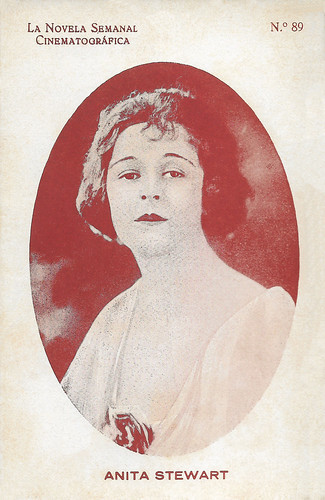
Spanish card by La Novela Semanal Cinematográfica, no. 89.
An actress in the foreground
Anita Stewart was born Anna Marie Stewart in Brooklyn in 1895. Her two siblings, actor/director George Stewart and actress Lucille Lee Stewart, would also act in films.
In 1911, when she was still attending Erasmus Hall High School in Brooklyn, 16-year-old Anita started her career playing extra and bit parts in films for the Vitagraph Studios at their New York City location.
She had her breakthrough with the box office hit A Tale of Two Cities (William J. Humphrey, 1911), adapted from Charles Dickens, and with an all-star cast including Maurice Costello, Florence Turner, Norma Talmadge , and John Bunny.
Over the next years, she quickly grew into an actress in the foreground. She appeared in a string of short comedies and dramas including The Forgotten Latchkey (Ralph Ince, 1913) with Harry Morey, and The White Feather (William J. Bauman, 1913).
Director Ralph Ince gave Stewart leading roles in his films A Million Bid (1914), her first real feature-length film, and The Sins of the Mothers (1914) with Julia Swayne Gordon.
She also starred with Earle Williams in a series of films: the trainwreck drama The Juggernaut (Ralph Ince, 1915), The Goddess (Ralph Ince, 1915), and the romantic drama My Lady's Slipper (Ralph Ince, 1916).
In 1917 Stewart married Rudolph Cameron, the brother of Ralph Ince. Stewart grew into a popular actress and was cast with big names such as Mae Busch and Barbara La Marr.

British postcard by Rotary Photo, no. S.75-5. Photo: Moody, N.Y.
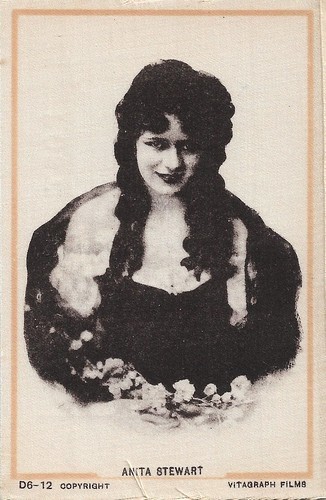
British postcard in the Novelty Series, no. D6-12. Photo: Vitagraph Films.
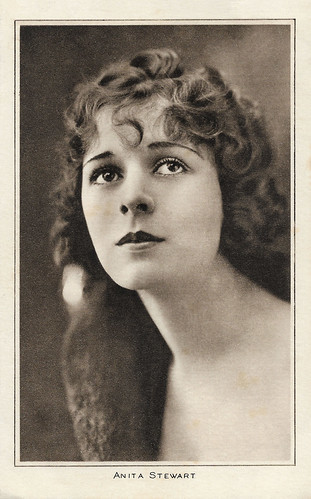
British postcard in the Pictures Portrait Gallery by Pictures Ltd., London, no. 111.
Her own production company
Anita Stewart left Vitagraph in 1918 for a contract with Louis B. Mayer and received a substantial salary increase. Stewart was promised her own production company at the Mayer studios in Los Angeles.
Between 1918 and 1919 Stewart produced seven moderately successful vehicles, starring in all of them. Her best-known film is Virtuous Wives (George Loane Tucker, 1918) with Conway Tearle and Hedda Hopper. Other titles include the Lois Weber film A Midnight Romance (1919) with Jack Holt, Marshall Neilan's Her Kingdom of Dreams (1919), and In Old Kentucky (Marshall Neilan, 1919).
Her films were enormously successful during the early 1920s, such as Sowing the Wind (John Stahl, 1921), The Woman He Married (Fred Niblo, 1922), etc.
From the mid-1920s, Stewart acted at various production companies, including Tiffany, Cosmopolitan, Fox, and even her old company Vitagraph. She mostly got first billing until 1928.
Her last silent film was Romance of a Rogue (King Baggot, 1928), starring H.B. Warner, and Stewart co-starring. After the emergence of the sound film in 1928, however, it went badly with Stewart's career.
Following Stewart's divorce from Cameron in 1928, Stewart married George Peabody Converse the following year. They divorced in 1946.
After making just one musical short, The Hollywood Handicap (Charles Lamont, 1932) with Bert Wheeler and the young John Wayne , Stewart retired from the screen. She was one of the wealthiest women in Hollywood.
Stewart wrote the murder mystery novel 'The Devil's Toy', published in New York in 1935 by E.P. Dutton. Though the book's dust jacket traded on the author's Hollywood connection, the plot concerned the killing of a stage actor and was set in San Francisco.
Anita Stewart died of a heart attack in 1961 in Beverly Hills, California. She was interred at Forest Lawn Memorial Park in Glendale, California, in the Sanctuary of Liberty. Anita Stewart has a star on the Hollywood Walk of Fame.
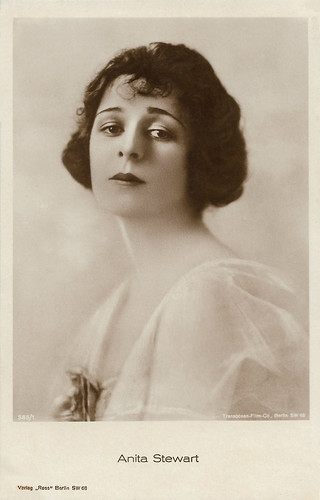
German postcard by Ross Verlag, no. 585/1, 1919-1924. Photo: Transocean Film-Co, Berlin.
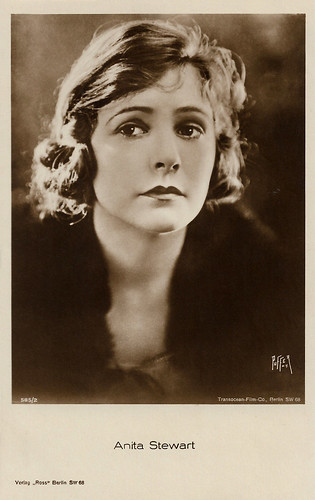
German postcard by Ross Verlag, no. 585/2, 1919-1924. Photo: Puffer, N.Y. / Transocean Film-Co, Berlin. Mistake! Actually, this is not Anita Stewart but Norma Talmadge . See our Flickr site
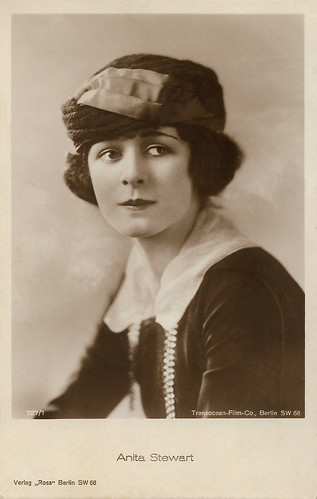
German postcard by Ross Verlag, no. 727/1, 1925-1926. Photo: Transocean Film-Co, Berlin.
Sources: Wikipedia (English and Dutch), and .

German postcard by Ross Verlag, no. 703/1, 1925-1926. Photo: Transocean Film-Co, Berlin.

American postcard by M.B.S.C.Co. (Max B. Sheffer Card Ci., Chicago), 1922. Photo: First National. Anita Stewart in Rose o' the Sea (Fred Niblo, 1922).

Spanish card by La Novela Semanal Cinematográfica, no. 89.
An actress in the foreground
Anita Stewart was born Anna Marie Stewart in Brooklyn in 1895. Her two siblings, actor/director George Stewart and actress Lucille Lee Stewart, would also act in films.
In 1911, when she was still attending Erasmus Hall High School in Brooklyn, 16-year-old Anita started her career playing extra and bit parts in films for the Vitagraph Studios at their New York City location.
She had her breakthrough with the box office hit A Tale of Two Cities (William J. Humphrey, 1911), adapted from Charles Dickens, and with an all-star cast including Maurice Costello, Florence Turner, Norma Talmadge , and John Bunny.
Over the next years, she quickly grew into an actress in the foreground. She appeared in a string of short comedies and dramas including The Forgotten Latchkey (Ralph Ince, 1913) with Harry Morey, and The White Feather (William J. Bauman, 1913).
Director Ralph Ince gave Stewart leading roles in his films A Million Bid (1914), her first real feature-length film, and The Sins of the Mothers (1914) with Julia Swayne Gordon.
She also starred with Earle Williams in a series of films: the trainwreck drama The Juggernaut (Ralph Ince, 1915), The Goddess (Ralph Ince, 1915), and the romantic drama My Lady's Slipper (Ralph Ince, 1916).
In 1917 Stewart married Rudolph Cameron, the brother of Ralph Ince. Stewart grew into a popular actress and was cast with big names such as Mae Busch and Barbara La Marr.

British postcard by Rotary Photo, no. S.75-5. Photo: Moody, N.Y.

British postcard in the Novelty Series, no. D6-12. Photo: Vitagraph Films.

British postcard in the Pictures Portrait Gallery by Pictures Ltd., London, no. 111.
Her own production company
Anita Stewart left Vitagraph in 1918 for a contract with Louis B. Mayer and received a substantial salary increase. Stewart was promised her own production company at the Mayer studios in Los Angeles.
Between 1918 and 1919 Stewart produced seven moderately successful vehicles, starring in all of them. Her best-known film is Virtuous Wives (George Loane Tucker, 1918) with Conway Tearle and Hedda Hopper. Other titles include the Lois Weber film A Midnight Romance (1919) with Jack Holt, Marshall Neilan's Her Kingdom of Dreams (1919), and In Old Kentucky (Marshall Neilan, 1919).
Her films were enormously successful during the early 1920s, such as Sowing the Wind (John Stahl, 1921), The Woman He Married (Fred Niblo, 1922), etc.
From the mid-1920s, Stewart acted at various production companies, including Tiffany, Cosmopolitan, Fox, and even her old company Vitagraph. She mostly got first billing until 1928.
Her last silent film was Romance of a Rogue (King Baggot, 1928), starring H.B. Warner, and Stewart co-starring. After the emergence of the sound film in 1928, however, it went badly with Stewart's career.
Following Stewart's divorce from Cameron in 1928, Stewart married George Peabody Converse the following year. They divorced in 1946.
After making just one musical short, The Hollywood Handicap (Charles Lamont, 1932) with Bert Wheeler and the young John Wayne , Stewart retired from the screen. She was one of the wealthiest women in Hollywood.
Stewart wrote the murder mystery novel 'The Devil's Toy', published in New York in 1935 by E.P. Dutton. Though the book's dust jacket traded on the author's Hollywood connection, the plot concerned the killing of a stage actor and was set in San Francisco.
Anita Stewart died of a heart attack in 1961 in Beverly Hills, California. She was interred at Forest Lawn Memorial Park in Glendale, California, in the Sanctuary of Liberty. Anita Stewart has a star on the Hollywood Walk of Fame.

German postcard by Ross Verlag, no. 585/1, 1919-1924. Photo: Transocean Film-Co, Berlin.

German postcard by Ross Verlag, no. 585/2, 1919-1924. Photo: Puffer, N.Y. / Transocean Film-Co, Berlin. Mistake! Actually, this is not Anita Stewart but Norma Talmadge . See our Flickr site

German postcard by Ross Verlag, no. 727/1, 1925-1926. Photo: Transocean Film-Co, Berlin.
Sources: Wikipedia (English and Dutch), and .
Published on May 30, 2020 22:00
May 29, 2020
Croissant Revisited
In February, EFSP paid attention to the French editor Croissant and its beautiful series of coloured postcards for early films Pathé Frères and Gaumont. Croissant published more interesting postcards with a link to the early cinema. My partner in crime, Ivo Blom collected this series of hand-coloured portrait postcards of French actors, who often appeared both in the theatre and in the cinema. The photographers were Henri Manuel and later Paul Boyer.
Constant Coquelin
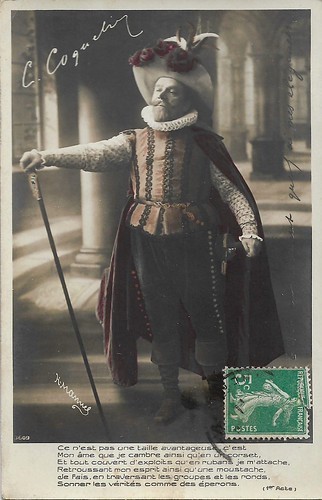
French postcard by Croissant, Paris, no. 3509. Photo: Henri Manuel, Paris. Constant Coquelin in the play 'Cyrano de Bergerac' (1897).
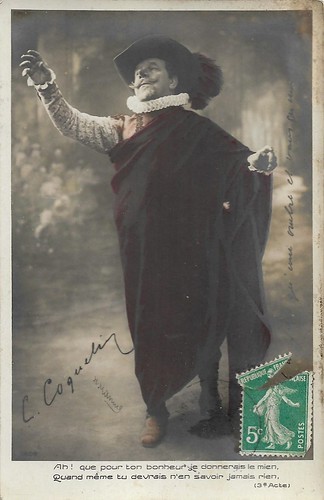
French postcard by Croissant, Paris, no. 3509. Photo: Henri Manuel, Paris. Constant Coquelin in the play 'Cyrano de Bergerac' (1897).
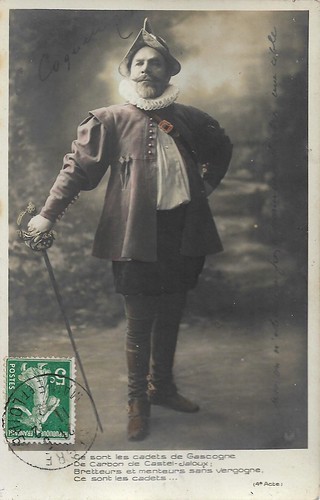
French postcard by Croissant, Paris, no. 3509. Photo: Henri Manuel, Paris. Constant Coquelin in the play 'Cyrano de Bergerac' (1897).
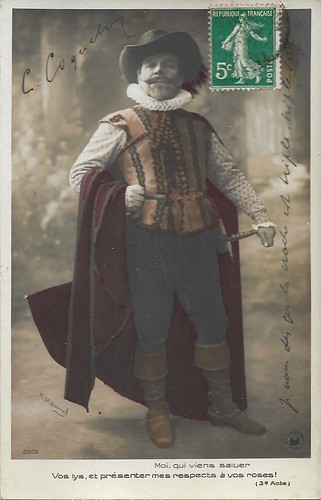
French postcard by Croissant, Paris, no. 3509. Photo: Henri Manuel, Paris. Constant Coquelin in the play 'Cyrano de Bergerac' (1897).
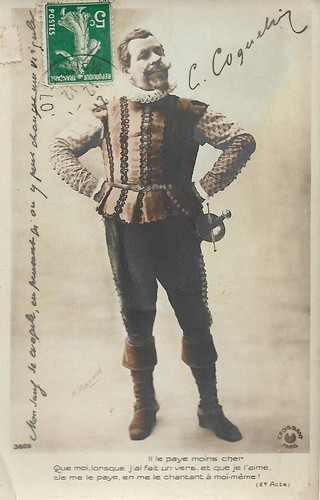
French postcard by Croissant, Paris, no. 3509. Photo: Henri Manuel, Paris. Constant Coquelin in the play 'Cyrano de Bergerac' (1897)
Benoît-Constant Coquelin (1841-1909), known as Coquelin aîné (Coquelin the Elder), was a French actor, who was known as one of the greatest theatrical figures of the age. He entered the Comédie-Française in 1860, became sociétaire there in 1864, left in 1887 to go on European and American tours, and returned as a Pensionnaire between 1890 and 1892. Despite the strict rules of the Comédie not play afterwards on other stages, Coquelin had a triumph in 1897 with Edmond Rostand's 'Cyrano de Bergerac' and would play it many times. In 1900, when he was almost sixty, Coquelin toured in America with Sarah Bernhardt and appeared on Broadway's Garden Theatre in a production of 'Cyrano de Bergerac' (Bernhardt played Roxane). On their return to France, he continued with his old colleague to appear in 'L'Aiglon', at the Théâtre Sarah Bernhardt. For his booming voice and his lyrical and fiery temperament, Rostand wrote 'Chantecler', but the actor died in 1909 before it could be performed by him. The only film of Coquelin senior was an early sound film shot by the Lumiere brothers operator Felix Mesguich in 1900, though some sources state Clement Maurice as the responsible one. It was a scene from Edmond Rostand's duel scene from 'Cyrano de Bergerac', a role Coquelin sr. had created in 1897. The film was shown at the Phono-Cinema-Theatre in Paris during the famous 1900 Exposition. After the exposition closed, Mesguich took the films on a three-month tour all over Europe. In 1930, the film was found back, together with early sound films. In 1952 it was inserted in the film Cinema parlant 1900.

French postcard by Croissant, Paris, no. 3523. Photo: Henri Manuel. Caption: Silvain de la Comédie Française.
Eugène Sylvain or Eugène Silvain (1851-1930), also known as Sylvain and Silvain, was a prominent French stage actor, though he is best remembered as the evil bishop Cauchon in Carl Theodor Dreyer’s silent film La passion de Jeanne d’Arc (1928). He entered the Comédie Française in 1878, became a Sociétaire in 1883, a Doyen between 1916 and 1928, and he left the company in 1928.
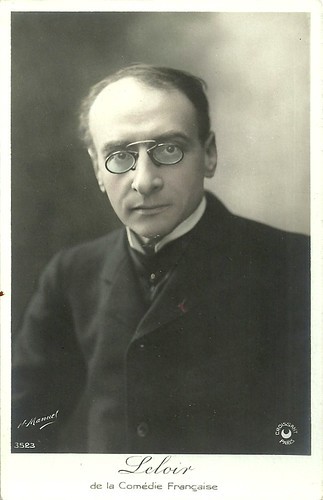
French postcard by Croissant, Paris, no. 3523. Photo: Henri Manuel. Caption: Leloir de la Comédie Française.
Louis Leloir a.k.a. Leloir (1860-1909), originally Louis Pierre Sallot, was a French actor, and a Sociétaire of the Comédie-Française between 1889 and 1909. Parallel to his stage career, he was appointed teacher at the Conservatoire de musique et déclamation in 1894, and vice-president of the Société des artistes dramatiques in 1897. Because of his courageous behaviour during the 1900 fire at the Comédie-Française, he was awarded the Légion d'Honneur the same year. When he died in 1909, he was a board member of the Comédie Française and one of its regular stage directors. Little is known about Leloir's involvement in the cinema. He may have written the script for the Film d'Art production Louis XI (André Calmettes, 1910), starring Emile Dehelly, while he may have made the poster for the Film d'Art production Un Duel sous Richelieu (André Calmettes, 1908), starring Henry Krauss.

French postcard by Croissant, Paris, no. 3523. Photo: Henri Manuel, Paris. Caption: Jacques Fenoux de la Comédie Française.
Jacques Fenoux entered the Comédie-Française in 1895, became a Sociétaire in 1906, retired in 1924, and became a Sociétaire Honoraire in 1925. As the site of the Comédie states: "Fenoux was the type of a conscientious member, able to move effortlessly from one job to another, from small to large parts. He was appointed honorary member in 1925 but continued to play until his last days. He barely disappeared two weeks after having last interpreted Bazile, from 'The Barber of Seville'." As far is known, his only film performance was in Jacques de Féraudy's Molière, sa vie, son oeuvre (1922), in which actors of the Comédie-Française can be seen rehearsing plays by Molière.

French postcard by Croissant, Paris, no. 3523. Photo: Henri Manuel, Paris. Caption: Truffier de la Comédie Française.
Jules Truffier (1856-1943) was a respected actor of the Comédie-Française. As far as known, he didn't act in a film, but as a teacher at the Conservatoire (from 1906 onward) he trained future screen actors. Jules Truffier's father, who had acted before starting in commerce, and was befriended with the actors Got and Delaunay, let his son study at the Parisian Conservatoire from 1873. Truffier jr. entered the Comédie-Française in 1875, became a Sociétaire there in 1888, retired in 1913, and in 1922 became a Sociétaire Honoraire. All in all, he played some 150 parts in an almost 40 years time span. In 1914, he quit acting in 'Maître Favilla', an adaptation by himself of a piece by George Sand, and in the same year he became manager of the Études classiques de la Comédie-Française, so the staging of the classic repertory by the Comédie. This he did until 1918/1919. Among his pupils at the Conservatoire, where he taught between 1906 and 1929, were Berthe Bovy, Pierre Dux, and Pierre Blanchar.
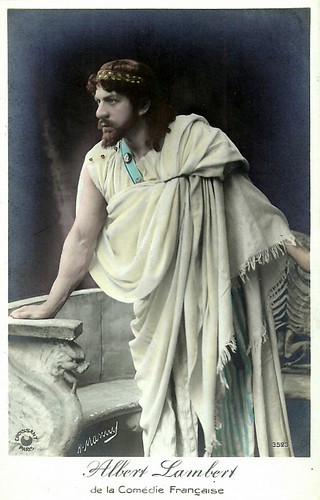
French postcard by Croissant, Paris, no. 3523. Photo: H. Manuel. Albert Lambert as Orestes.
Albert Lambert (1865-1941), aka Albert Lambert fils, was a French stage and screen actor, who was for a long time part of the Comédie-Française. He also played in several early French Film d’Art films, first of all in L'Assassinat du Duc de Guise (1908).
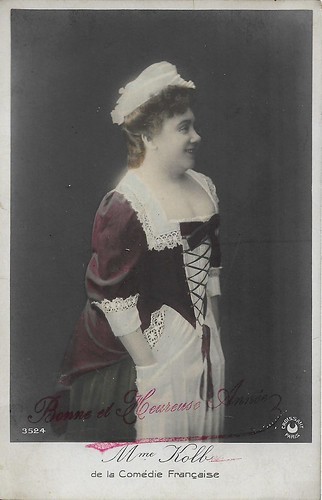
French postcard by Croissant, Paris, no. 3524. Photo Henri Manuel, Paris. Caption: Mme. Kolb de la Comédie Française.
Thérèse Kolb (1856-1935) was a reputed French stage actress, who also had a career in French silent cinema. Born Marie-Thérèse Kolb in Altkirch (Alsace, Haut-Rhin), she won the first prize at the Conservatoire de Paris and began to act at the Théâtre de l'Odéon with Coquelin the Elder and Sarah Bernhardt, whom she followed on a tour around the United States in 1882. Kolb entered the Comédie-Française in 1898, before becoming the 338th member in 1904. She was named an honorary member in 1923. While she had one occasional first role in 1912 in Le Fils prodigue by Camille de Morlhon, from the late 1910s Kolb started a steady second career in acting in French silent cinema. In 1921-1922, she was Mme Bicard in four Le Bouif comedies with Tramel, directed by Henri Pouctal and Louis Osmont, while she also had major parts in L'ami Fritz (René Hervil, 1920), Blanchette (Hervil, 1921), Yasmina (André Hugon, 1927), L'île d'amour (Berthe Dagmar, Jean Durand, 1929), L'appassionata (André Liabel, Léon Mathot, 1929), and Le crime de Sylvestre Bonnard (André Berthomieu, 1929). In 1935 Thérèse Kolb died in Levallois-Perret (Seine) and she was buried in the Altkirch cemetery. She was the mother of Jean Kolb.
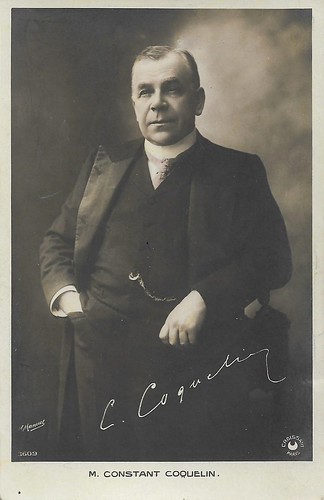
French postcard by Croissant, Paris, no. 3609. Photo: Henri Manuel. Caption: M. Constant Coquelin.
Sarah Bernhardt

French postcard by Croissant, Paris, no. 3690. Photo: Paul Boyer. Sarah Bernhardt in the play 'L'Aiglon' (1900) by Edmond Rostand.
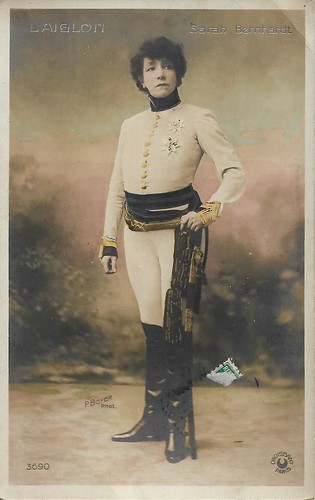
French postcard by Croissant, Paris, no. 3690. Photo: Paul Boyer. Sarah Bernhardt in the play 'L'Aiglon' (1900) by Edmond Rostand.
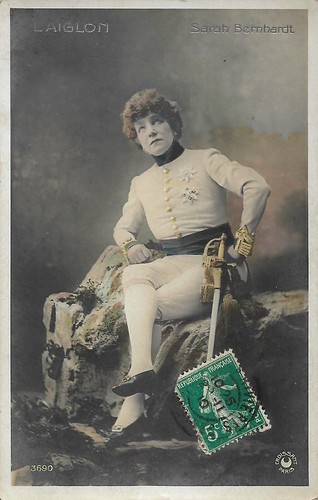
French postcard by Croissant, Paris, no. 3690. Photo: Paul Boyer. Sarah Bernhardt in the play 'L'Aiglon' (1900) by Edmond Rostand.
French vedette Sarah Bernhardt (1844-1923) has been referred to as 'the most famous actress in the history of the world'. She developed a reputation as a serious dramatic actress, earning her the nickname 'The Divine Sarah'. Bernhardt made her fame on the stages of Europe in the 1870s and was soon high in demand in both Americas too. And she was one of the first film stars. What a woman!
Sources: Comédie-Française (French), Filmographie Le Film d'Art by Eric Le Roy (French), Wikipedia (French) and
And please, check out our earlier post on Croissant.
Constant Coquelin

French postcard by Croissant, Paris, no. 3509. Photo: Henri Manuel, Paris. Constant Coquelin in the play 'Cyrano de Bergerac' (1897).

French postcard by Croissant, Paris, no. 3509. Photo: Henri Manuel, Paris. Constant Coquelin in the play 'Cyrano de Bergerac' (1897).

French postcard by Croissant, Paris, no. 3509. Photo: Henri Manuel, Paris. Constant Coquelin in the play 'Cyrano de Bergerac' (1897).

French postcard by Croissant, Paris, no. 3509. Photo: Henri Manuel, Paris. Constant Coquelin in the play 'Cyrano de Bergerac' (1897).

French postcard by Croissant, Paris, no. 3509. Photo: Henri Manuel, Paris. Constant Coquelin in the play 'Cyrano de Bergerac' (1897)
Benoît-Constant Coquelin (1841-1909), known as Coquelin aîné (Coquelin the Elder), was a French actor, who was known as one of the greatest theatrical figures of the age. He entered the Comédie-Française in 1860, became sociétaire there in 1864, left in 1887 to go on European and American tours, and returned as a Pensionnaire between 1890 and 1892. Despite the strict rules of the Comédie not play afterwards on other stages, Coquelin had a triumph in 1897 with Edmond Rostand's 'Cyrano de Bergerac' and would play it many times. In 1900, when he was almost sixty, Coquelin toured in America with Sarah Bernhardt and appeared on Broadway's Garden Theatre in a production of 'Cyrano de Bergerac' (Bernhardt played Roxane). On their return to France, he continued with his old colleague to appear in 'L'Aiglon', at the Théâtre Sarah Bernhardt. For his booming voice and his lyrical and fiery temperament, Rostand wrote 'Chantecler', but the actor died in 1909 before it could be performed by him. The only film of Coquelin senior was an early sound film shot by the Lumiere brothers operator Felix Mesguich in 1900, though some sources state Clement Maurice as the responsible one. It was a scene from Edmond Rostand's duel scene from 'Cyrano de Bergerac', a role Coquelin sr. had created in 1897. The film was shown at the Phono-Cinema-Theatre in Paris during the famous 1900 Exposition. After the exposition closed, Mesguich took the films on a three-month tour all over Europe. In 1930, the film was found back, together with early sound films. In 1952 it was inserted in the film Cinema parlant 1900.

French postcard by Croissant, Paris, no. 3523. Photo: Henri Manuel. Caption: Silvain de la Comédie Française.
Eugène Sylvain or Eugène Silvain (1851-1930), also known as Sylvain and Silvain, was a prominent French stage actor, though he is best remembered as the evil bishop Cauchon in Carl Theodor Dreyer’s silent film La passion de Jeanne d’Arc (1928). He entered the Comédie Française in 1878, became a Sociétaire in 1883, a Doyen between 1916 and 1928, and he left the company in 1928.

French postcard by Croissant, Paris, no. 3523. Photo: Henri Manuel. Caption: Leloir de la Comédie Française.
Louis Leloir a.k.a. Leloir (1860-1909), originally Louis Pierre Sallot, was a French actor, and a Sociétaire of the Comédie-Française between 1889 and 1909. Parallel to his stage career, he was appointed teacher at the Conservatoire de musique et déclamation in 1894, and vice-president of the Société des artistes dramatiques in 1897. Because of his courageous behaviour during the 1900 fire at the Comédie-Française, he was awarded the Légion d'Honneur the same year. When he died in 1909, he was a board member of the Comédie Française and one of its regular stage directors. Little is known about Leloir's involvement in the cinema. He may have written the script for the Film d'Art production Louis XI (André Calmettes, 1910), starring Emile Dehelly, while he may have made the poster for the Film d'Art production Un Duel sous Richelieu (André Calmettes, 1908), starring Henry Krauss.

French postcard by Croissant, Paris, no. 3523. Photo: Henri Manuel, Paris. Caption: Jacques Fenoux de la Comédie Française.
Jacques Fenoux entered the Comédie-Française in 1895, became a Sociétaire in 1906, retired in 1924, and became a Sociétaire Honoraire in 1925. As the site of the Comédie states: "Fenoux was the type of a conscientious member, able to move effortlessly from one job to another, from small to large parts. He was appointed honorary member in 1925 but continued to play until his last days. He barely disappeared two weeks after having last interpreted Bazile, from 'The Barber of Seville'." As far is known, his only film performance was in Jacques de Féraudy's Molière, sa vie, son oeuvre (1922), in which actors of the Comédie-Française can be seen rehearsing plays by Molière.

French postcard by Croissant, Paris, no. 3523. Photo: Henri Manuel, Paris. Caption: Truffier de la Comédie Française.
Jules Truffier (1856-1943) was a respected actor of the Comédie-Française. As far as known, he didn't act in a film, but as a teacher at the Conservatoire (from 1906 onward) he trained future screen actors. Jules Truffier's father, who had acted before starting in commerce, and was befriended with the actors Got and Delaunay, let his son study at the Parisian Conservatoire from 1873. Truffier jr. entered the Comédie-Française in 1875, became a Sociétaire there in 1888, retired in 1913, and in 1922 became a Sociétaire Honoraire. All in all, he played some 150 parts in an almost 40 years time span. In 1914, he quit acting in 'Maître Favilla', an adaptation by himself of a piece by George Sand, and in the same year he became manager of the Études classiques de la Comédie-Française, so the staging of the classic repertory by the Comédie. This he did until 1918/1919. Among his pupils at the Conservatoire, where he taught between 1906 and 1929, were Berthe Bovy, Pierre Dux, and Pierre Blanchar.

French postcard by Croissant, Paris, no. 3523. Photo: H. Manuel. Albert Lambert as Orestes.
Albert Lambert (1865-1941), aka Albert Lambert fils, was a French stage and screen actor, who was for a long time part of the Comédie-Française. He also played in several early French Film d’Art films, first of all in L'Assassinat du Duc de Guise (1908).

French postcard by Croissant, Paris, no. 3524. Photo Henri Manuel, Paris. Caption: Mme. Kolb de la Comédie Française.
Thérèse Kolb (1856-1935) was a reputed French stage actress, who also had a career in French silent cinema. Born Marie-Thérèse Kolb in Altkirch (Alsace, Haut-Rhin), she won the first prize at the Conservatoire de Paris and began to act at the Théâtre de l'Odéon with Coquelin the Elder and Sarah Bernhardt, whom she followed on a tour around the United States in 1882. Kolb entered the Comédie-Française in 1898, before becoming the 338th member in 1904. She was named an honorary member in 1923. While she had one occasional first role in 1912 in Le Fils prodigue by Camille de Morlhon, from the late 1910s Kolb started a steady second career in acting in French silent cinema. In 1921-1922, she was Mme Bicard in four Le Bouif comedies with Tramel, directed by Henri Pouctal and Louis Osmont, while she also had major parts in L'ami Fritz (René Hervil, 1920), Blanchette (Hervil, 1921), Yasmina (André Hugon, 1927), L'île d'amour (Berthe Dagmar, Jean Durand, 1929), L'appassionata (André Liabel, Léon Mathot, 1929), and Le crime de Sylvestre Bonnard (André Berthomieu, 1929). In 1935 Thérèse Kolb died in Levallois-Perret (Seine) and she was buried in the Altkirch cemetery. She was the mother of Jean Kolb.

French postcard by Croissant, Paris, no. 3609. Photo: Henri Manuel. Caption: M. Constant Coquelin.
Sarah Bernhardt

French postcard by Croissant, Paris, no. 3690. Photo: Paul Boyer. Sarah Bernhardt in the play 'L'Aiglon' (1900) by Edmond Rostand.

French postcard by Croissant, Paris, no. 3690. Photo: Paul Boyer. Sarah Bernhardt in the play 'L'Aiglon' (1900) by Edmond Rostand.

French postcard by Croissant, Paris, no. 3690. Photo: Paul Boyer. Sarah Bernhardt in the play 'L'Aiglon' (1900) by Edmond Rostand.
French vedette Sarah Bernhardt (1844-1923) has been referred to as 'the most famous actress in the history of the world'. She developed a reputation as a serious dramatic actress, earning her the nickname 'The Divine Sarah'. Bernhardt made her fame on the stages of Europe in the 1870s and was soon high in demand in both Americas too. And she was one of the first film stars. What a woman!
Sources: Comédie-Française (French), Filmographie Le Film d'Art by Eric Le Roy (French), Wikipedia (French) and
And please, check out our earlier post on Croissant.
Published on May 29, 2020 22:00
May 28, 2020
R.I.P.: Irm Hermann (1942-2020)
On 26 May 2020, the German actress and assistant director Irm Hermann passed away in Berlin after a short illness. She was the muse and a close friend of Rainer Werner Fassbinder and played roles in 24 of his films including Die bitteren Tränen der Petra von Kant (1972). Overall, she appeared in over 160 film and television productions until 2018. Irm Hermann was 77.

German postcard by Franz Josef Rüdel, Filmpostkartenverlag, Hamburg. Photo: Margarete Redl-von Peinen.
24 films with Fassbinder
Irmgard Hermann was born in 1942 in Munich, in Nazi Germany.
In 1966, she worked as a secretary at the ADAC, Germany's biggest automobile club, when she got to know Rainer Werner Fassbinder . They became close friends. He convinced her to quit her job to work with him although she lacked formal training as an actress.
In the same year, Hermann starred in her debut role in Fassbinder's short film Der Stadtstreicher/The City Tramp (Rainer Werner Fassbinder, 1966).
She and Fassbinder made 24 films and TV series together: Der Stadtstreicher (1966), Der Bräutigam, die Komödiantin und der Zuhälter (Jean-Marie Straub, 1968), Katzelmacher (1969), Liebe ist kälter als der Tod (1969), Götter der Pest (1970), Der amerikanische Soldat (1970), Effi Briest (1970), Warum läuft Herr R. Amok (1970), Pioniere in Ingolstadt (1971), Mathias Kneissl (Reinhard Hauff, 1971), the TV series Acht Stunden sind kein Tag (1972), Die bitteren Tränen der Petra von Kant/The Bitter Tears of Petra von Kant (1972), Händler der vier Jahreszeiten/The Merchant of Four Seasons (1972), Wildwechsel (1973; on which she was also the assistant director), Die Zärtlichkeit der Wölfe (Ulli Lommel, 1973), Angst essen Seele auf/Ali: Fear Eats the Soul (1974), Nora Helmer (1974), Angst vor der Angst (1975), Faustrecht der Freiheit (1975; on which she was also the assistant director), Mutter Küsters' Fahrt zum Himmel (1975), Schatten der Engel (Daniel Schmid, 1976), Frauen in New York (1977), the TV series Berlin Alexanderplatz (1980), and Lili Marleen (1981).

German postcard by Franz Josef Rüdel, Filmpostkartenverlag, Hamburg. Photo: Peter Paul Hammerschmidt, Berlin.
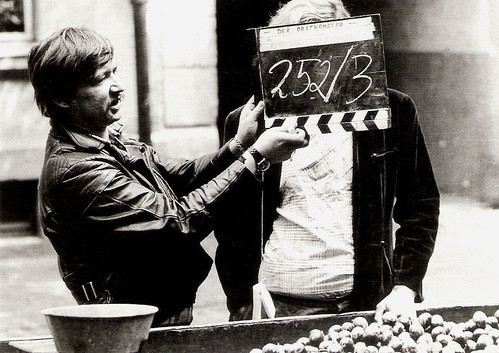
German postcard by Verlag Hias Schaschko, München (Munich), no. 209. Photo: Rainer Werner Fassbinder during the shooting of Händler der vier Jahreszeiten/The Merchant of Four Seasons (1971), then still called Der Obsthändler/The Grocer.
Independence in Berlin
In 1975, Irm Hermann left Munich and Fassbinder and moved to Berlin to be more independent. In 1976, she married children's book writer Dietmar Roberg. They had two children, son Franz Tizian Roberg (1977), and son Fridolin Roberg (1981).
In the cinema, she worked more often for other directors. She worked with Werner Herzog in his film Woyzeck (1979) starring Klaus Kinski , with Hans Geissendorfer in his Thomas Mann adaptation Der Zauberberg/The Magic Mountain (1982), with Rod Steiger, with Percy Adlon in Fünf letzte Tage/The Five Last Days (1982), and with Ulrike Ottinger in Dorian Gray im Spiegel der Boulevardpresse/Dorian Gray in the Mirror of the Yellow Press (1984).
From 1987, she was an ensemble member of the Freie Volksbühne Berlin. She continued to make films, including Johanna D'Arc of Mongolia (Elrike Ottinger, 1989), Tigerstreifenbaby wartet auf Tarzan/Tigerstripe Baby Is Waiting for Tarzan (Rudolf Thome, 1998), the family film Mein Bruder ist ein Hund/My Brother Is a Dog (Peter Timm, 2004), the farce Reine Geschmacksache/Fashion victims (Ingo Rasper, 2007), and Anonyma - Eine Frau in Berlin/A Woman in Berlin (Max Färberböck, 2008) starring Nina Hoss .
Her later films included Fack ju Göhte 3/Suck Me Shakespeer 3 (Bora Dagtekin, 2017) with Elyas M'Barek and Katja Riemann , and Zwei Herren im Anzug/Two Men in Suits (Josef Bierbichler, 2018). Her last screen role was in the TV series Labaule & Erben (2019), the story of the publishing family Labaule in Germany.
Irm Hermann died in 2020 in Berlin, Germany.

German autograph card. Photo: Claudius Pflug.
Scene from Die bitteren Tränen der Petra von Kant (1972) also with Margit Carstensen. Source: Emanuele Tealdi (YouTube).
Sources: Hans Beerekamp (Het Schimmenrijk - Dutch) Wikipedia and .

German postcard by Franz Josef Rüdel, Filmpostkartenverlag, Hamburg. Photo: Margarete Redl-von Peinen.
24 films with Fassbinder
Irmgard Hermann was born in 1942 in Munich, in Nazi Germany.
In 1966, she worked as a secretary at the ADAC, Germany's biggest automobile club, when she got to know Rainer Werner Fassbinder . They became close friends. He convinced her to quit her job to work with him although she lacked formal training as an actress.
In the same year, Hermann starred in her debut role in Fassbinder's short film Der Stadtstreicher/The City Tramp (Rainer Werner Fassbinder, 1966).
She and Fassbinder made 24 films and TV series together: Der Stadtstreicher (1966), Der Bräutigam, die Komödiantin und der Zuhälter (Jean-Marie Straub, 1968), Katzelmacher (1969), Liebe ist kälter als der Tod (1969), Götter der Pest (1970), Der amerikanische Soldat (1970), Effi Briest (1970), Warum läuft Herr R. Amok (1970), Pioniere in Ingolstadt (1971), Mathias Kneissl (Reinhard Hauff, 1971), the TV series Acht Stunden sind kein Tag (1972), Die bitteren Tränen der Petra von Kant/The Bitter Tears of Petra von Kant (1972), Händler der vier Jahreszeiten/The Merchant of Four Seasons (1972), Wildwechsel (1973; on which she was also the assistant director), Die Zärtlichkeit der Wölfe (Ulli Lommel, 1973), Angst essen Seele auf/Ali: Fear Eats the Soul (1974), Nora Helmer (1974), Angst vor der Angst (1975), Faustrecht der Freiheit (1975; on which she was also the assistant director), Mutter Küsters' Fahrt zum Himmel (1975), Schatten der Engel (Daniel Schmid, 1976), Frauen in New York (1977), the TV series Berlin Alexanderplatz (1980), and Lili Marleen (1981).

German postcard by Franz Josef Rüdel, Filmpostkartenverlag, Hamburg. Photo: Peter Paul Hammerschmidt, Berlin.

German postcard by Verlag Hias Schaschko, München (Munich), no. 209. Photo: Rainer Werner Fassbinder during the shooting of Händler der vier Jahreszeiten/The Merchant of Four Seasons (1971), then still called Der Obsthändler/The Grocer.
Independence in Berlin
In 1975, Irm Hermann left Munich and Fassbinder and moved to Berlin to be more independent. In 1976, she married children's book writer Dietmar Roberg. They had two children, son Franz Tizian Roberg (1977), and son Fridolin Roberg (1981).
In the cinema, she worked more often for other directors. She worked with Werner Herzog in his film Woyzeck (1979) starring Klaus Kinski , with Hans Geissendorfer in his Thomas Mann adaptation Der Zauberberg/The Magic Mountain (1982), with Rod Steiger, with Percy Adlon in Fünf letzte Tage/The Five Last Days (1982), and with Ulrike Ottinger in Dorian Gray im Spiegel der Boulevardpresse/Dorian Gray in the Mirror of the Yellow Press (1984).
From 1987, she was an ensemble member of the Freie Volksbühne Berlin. She continued to make films, including Johanna D'Arc of Mongolia (Elrike Ottinger, 1989), Tigerstreifenbaby wartet auf Tarzan/Tigerstripe Baby Is Waiting for Tarzan (Rudolf Thome, 1998), the family film Mein Bruder ist ein Hund/My Brother Is a Dog (Peter Timm, 2004), the farce Reine Geschmacksache/Fashion victims (Ingo Rasper, 2007), and Anonyma - Eine Frau in Berlin/A Woman in Berlin (Max Färberböck, 2008) starring Nina Hoss .
Her later films included Fack ju Göhte 3/Suck Me Shakespeer 3 (Bora Dagtekin, 2017) with Elyas M'Barek and Katja Riemann , and Zwei Herren im Anzug/Two Men in Suits (Josef Bierbichler, 2018). Her last screen role was in the TV series Labaule & Erben (2019), the story of the publishing family Labaule in Germany.
Irm Hermann died in 2020 in Berlin, Germany.

German autograph card. Photo: Claudius Pflug.
Scene from Die bitteren Tränen der Petra von Kant (1972) also with Margit Carstensen. Source: Emanuele Tealdi (YouTube).
Sources: Hans Beerekamp (Het Schimmenrijk - Dutch) Wikipedia and .
Published on May 28, 2020 22:00
May 27, 2020
Photo by G.B. Poletto
G.B. Poletto (1915-1988) was one of the most prolific set photographers that worked in the Italian cinema of the 1950s and 1960s. In 1950, Titanus, one of the major studios, offered him an exclusive contract, which committed him to be the still photographer for all the films produced by the studio. Poletto worked with such famous directors as Roberto Rossellini, Federico Fellini, and Luchino Visconti, but he also photographed many genre films, including the classic romantic comedies Pane, amore e fantasia/Bread, Love and Dreams (1953) with Gina Lollobrigida, and Poveri ma belli/Poor But Beautiful (Dino Risi, 1957), starring Marisa Allasio. His photos were used for countless European film star postcards.

German postcard by Universum-Film Aktiengesellschaft (UFA), Berlin-Tempelhof, no. CK-174. Retail price: 30 Pfg. Photo: G.B. Poletto / UFA.
Italian actress Marisa Allasio (1936) was a glamorous starlet who appeared in nearly twenty pictures in the 1950s. She was nicknamed ‘The Italian Jayne Mansfield’. In 1958 her career stopped abruptly when she married and became a countess.

Yugoslavian postcard by NPO, no. G5. Photo: G.B. Poletto. Gina Lollobrigida and donkey in Pane, amore e fantasia /Bread, Love and Dreams (Luigi Comencini, 1953).
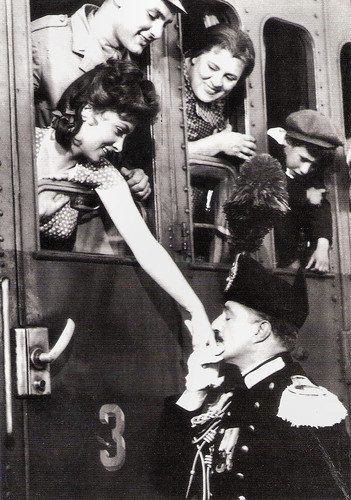
Italian postcard in the I Carabinieri nel Cinema series. Photo: Titanus. Photo: G.B. Poletto. Roberto Risso , Gina Lollobrigida and Vittorio De Sica in Pane, amore e gelosia/Bread, Love and Jealousy (Luigi Comencini, 1954).
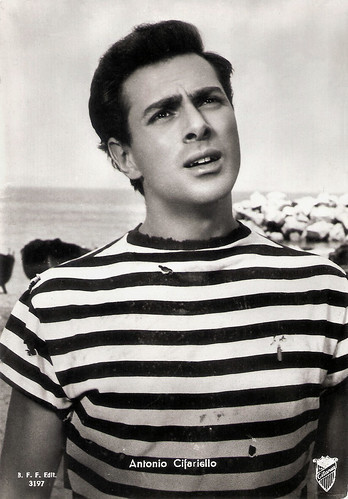
Italian postcard by Casa Editr. Ballerini & Fratini, Firenze (B.F.F. Edit.), no. 3197. Photo: G.B. Poletto. Titanus. Antonio Cifariello in Pane, amore e...../Scandal in Sorrento (Dino Risi, 1955).
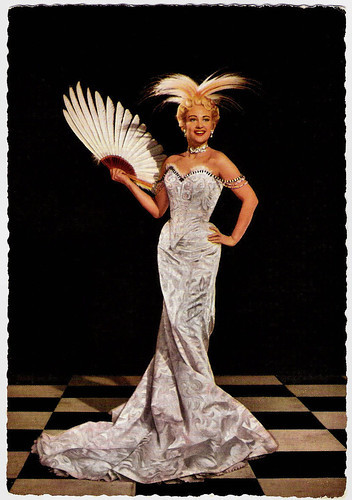
German postcard by UFA, Berlin-Tempelhof, no. 58. Retail price: 50 Pfg. Photo: G.B. Poletto / UFA.
Sex symbol Martine Carol (1920-1967) was one of the most beautiful women of the French cinema. During the early 1950s, she was a top box office draw as an elegant blonde seductress. Her private life was filled with turmoil including a suicide attempt, drug abuse, a kidnapping, and her mysterious death.
Poor But Beautiful
Giovanni Battista Poletto was born in Rome in 1915. His parents were Vittorio Poletto, originally from Rovigo, and Assunta Battistini, from Cesena. He attended elementary school in the Pinciano district, where he was born, and once he obtained a middle school license, he decided not to continue his studies.
In the 1930s he enrolled in a course for aviation photographers organised by the Air Force Ministry. Shortly thereafter, he began his career as a professional photographer at Ala Littoria, taking aerial photographs. During the war, he served in the aeronautics as a laboratory photographer. Transferred to Volta Mantovana, in 1943, he met the eighteen-year-old Paola Panizza, whom he married in 1946. Four children were born from the wedding: Donatella (1947), Carlo (1949), Laura (1953) and Alessandra (1958).
Once back in Rome with his wife, Poletto abandoned aerial photography in favour of reportage photography. He began to collaborate with such magazines as L’Europeo and Oggi and started his first contact with the world of cinema. In 1949 he met Roberto Rossellini, who wanted him as a set photographer of Stromboli, terra di Dio/Stromboli (Roberto Rossellini, 1950), starring Ingrid Bergman .
In 1950, the producer Goffredo Lombardo, head of one of the major studios, Titanus, offered him an exclusive contract, which committed him to be the still photographer for all the films produced by the studio. To cope with the growing amount of work, Poletto was forced to significantly expand the number of employees of his Agenzia Poletto - opened just before in the centre of Rome, in Via della Mercede 16 - which came to count 19 employees including photographers and printers.
For 'G.B. Poletto' - as he used to sign his photos - the first half of the 1950s was very intense on a professional level, with an average coverage of eleven sets per year. In 1951, he worked twice with the director and writer Mario Soldati, for the comedy O.K. Nerone/O.K. Nero (1951) starring Walter Chiari and Silvana Pampanini , and for È l'amor che mi rovina/It is love that ruins me (1951), with Chiari and Lucia Bosé .
In 1952, he photographed two episodes of Les sept péchés capitaux/The Seven Deadly Sins: L'Envie/Envy by Roberto Rossellini, and L'Avarice et la colère/Avarice and Anger by Eduardo De Filippo . With De Filippo, he also worked in the same year in the comedies Marito e moglie/Husband and wife (1952) and Ragazze da marito/Married Girls (1952).
The following year, he witnessed the directorial debut of Antonio Pietrangeli with Il sole negli occhi/The sun in his eyes (1953), for which the director earned a Silver Ribbon. He also made the still photos of Un marito per Anna Zaccheo/A husband for Anna Zaccheo (1954) by Giuseppe De Santis with whom he also collaborated for Uomini e lupi/Men and Wolves (Giuseppe De Santis, 1957) and Roberto Rossellini's Viaggio in Italia/Journey to Italy (1954), with whom he had built up mutual esteem and friendship in the meantime.
He resumed the sets of Pane, amore e fantasia/Bread, Love and Dreams (Luigi Comencini, 1953) with Vittorio De Sica and Gina Lollobrigida , and Poveri ma belli/Poor But Beautiful (Dino Risi, 1957), starring Marisa Allasio , Maurizio Arena , and Renato Salvatori . Of these popular 'sagas', he photographed all the sequels too.
Poletto also collaborated with Michelangelo Antonioni for La Signora senza Camelie/The Lady Without Camelias (1953), of which the photos depicting the young protagonist, Lucia Bosé , hover in memory.
In the same year, he worked on the set of Quand tu liras cette lettre/When You Read This Letter (Jean-Pierre Melville, 1953) with Juliette Gréco , and of the anthology film Siamo donne (Gianni Franciolini, Alfredo Guarini, Roberto Rossellini, Luchino Visconti, Luigi Zampa, 1953), starring Alida Valli , Ingrid Bergman , Isa Miranda , and Anna Magnani , of which he did all five episodes.
At the same time, he was on the sets of important authors of genre films: Raffaello Matarazzo, a prolific director of such melodramas as Chi è senza peccato..../Who is without sin ... (1952) and Torna!/Tears of Love (1954), and comedy directors like Camillo Mastrocinque for Attanasio, cavallo vanesio/Athanasius, the vain horse(1953) and Steno for Mio figlio Nerone/My son Nero (1956).
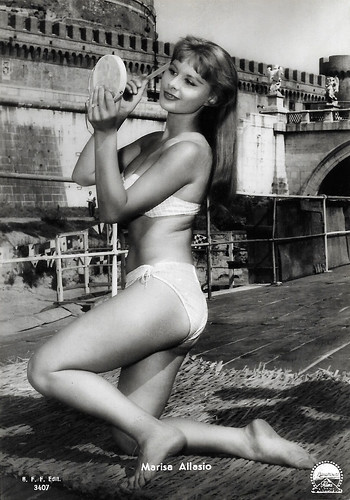
Italian postcard by Casa Editr. Ballerini & Fratini, Firenze, no. 3407. Photo: G.B. Poletto / Paramount / Titanus. Marisa Allasio in Poveri ma belli/Poor but beautiful (Dino Risi, 1957).
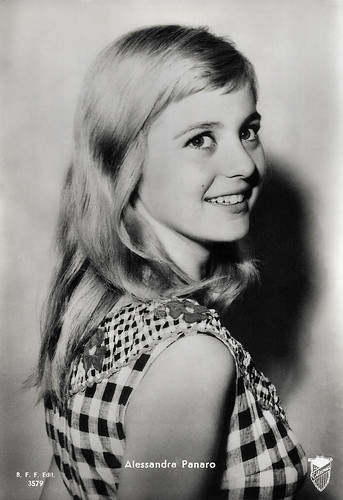
Italian postcard by Casa Edit. Ballerini & Fratini, Firenze (B.F.F.), no. 3579. Photo: G.B. Poletto / Titanus
Alessandra Panaro (1939-2019) was an Italian film actress of the late 1950s and early 1960s. She is best known for Luchino Visconti's crime drama Rocco e i suoi fratelli/Rocco and His Brothers (1960).
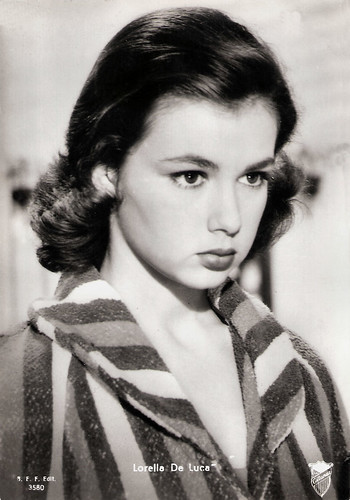
Italian postcard by B.F.F. Edit. (Casa Editr. Ballerini & Fratini, Firenze), no. 3580. Photo: G.B. Poletto / Titanus.
After her 'discovery' at the age of 14, Italian actress Lorella De Luca (1940-2014) played naïve young girls in several dramas and comedies. These made her one of the best-known ingénues of the Italian cinema of the late 1950s. De Luca was married to film director Duccio Tessari.
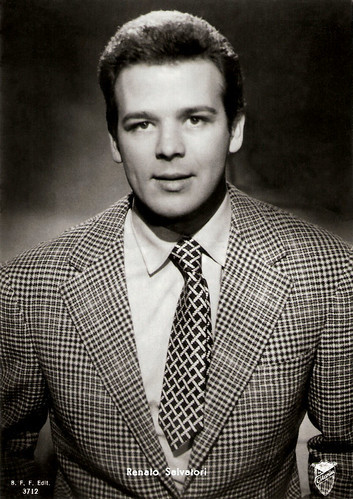
Italian postcard by B.F.F. Edit. (Casa Editr. Ballerini & Fratini, Firenze), no. 3712. Photo: G.B. Poletto / Titanus. Renato Salvatori in Poveri Millionari/Poor Millionaires (Dino Risi, 1959).
Renato Salvatori (1933-1988) was a popular, good-looking Italian actor of the 1950s and 1960s. His apex was his role as Simone in Visconti’s Rocco e i suoi fratelli/Rocco and His Brothers (1960).
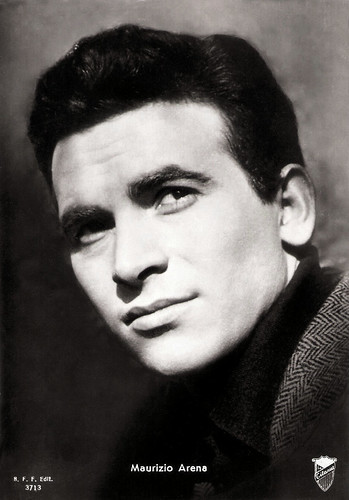
Italian postcard by Casa Editr. Ballerini & Fratini, Firenze, no. 3713. Photo: G.B. Poletto / Titanus. Maurizio Arena in Poveri milionari/Poor Millionaires (Dino Risi, 1958).
Italian film actor Maurizio Arena (1933-1979) appeared in 78 films between 1952 and 1978. In the late 1950s, he became popular as the poor but handsome Roman working-class boy in a comedy trilogy by Dino Risi.
Federico Fellini
G.B. Poletto was among the photographers who contributed to launching Sophia Loren as one of the main divas of Italian cinema: the set photos of Il segno di Venere/The Sign of Venus (Dino Risi, 1955) and the promotional photos of Peccato che sia una canaglia/Too Bad She's Bad (Alessandro Blasetti, 1955), are still today among the most recognisable shots of the actress.
Titanus was always careful to diversify its offer, producing films by Rossellini, Federico Fellini, Luchino Visconti, high budget films in French and American co-productions, but also Italian comedies, melodramas, adventure films, Peplums. This mixture of author films and more widely consumed films reverberated on Poletto's work and represented a constant in his work, especially in the second part of his career.
From the mid-sixties, he often photographed the 'Musicarelli', hugely popular musical comedies starring the most famous pop singers of the time. Among these are Non son degno di te/I am not worthy of you (Ettore Maria Fizzarotti, 1965) with Gianni Morandi , and Non stuzzicate la zanzara/Don't whet the mosquito (Lina Wertmüller, 1967), starring Rita Pavone .
In his professional career, he also met Alberto Lattuada, with whom he collaborated for La spiaggia/Riviera (Alberto Lattuada, 1954) with Martine Carol , and Scuola elementare/Elementary school (Alberto Lattuada, 1955). The relationship with the Milanese director continued in 1960 with Lettere di una novizia/Letters by a Novice (Alberto Lattuada, 1960) and I Dolci decanni/Sweet Deceptions (Alberto Lattuada, 1960). The protagonist of this last film was Catherine Spaak , in the role of a teenager in love with a man much older than her. The film caused a sensation and was subjected to a very long censorship odyssey until 1964 when Lattuada and the producer Lombardo were acquitted of the accusation of obscenity.
In one of his few interviews, Poletto underlined how in Italy, unlike what happened in American cinema, the photographer was called to simultaneously cover multiple roles: to produce the promotional material of the film (envelopes for the press, posters) he had to faithfully resume what had been shot by the camera, preserving its angle of observation, and at the same time had to "document the birth of the film by shooting the director, the actors, the technicians at work or in moments of pause".
The 'still photography', as it was commonly understood, therefore constituted only a part of the photographer's overall work, not including the less quoted 'set photography' which left him more expressive freedom and which dissociated himself from the idea of cinema as a machine producing illusions "revealing 'the artifice'". Initially, the set, as the main place of the cinematographic creation, was not crossed by the photographer's eye. Later, Poletto began to show the space in which the film was physically made to further increase its charm and the power of seduction.
His colour images of Giulietta degli spiriti/Juliet of the Spirits (Federico Fellini, 1965) are famous. Poletto, widening the frame, shows the 'trick' hidden by the camera: the crane that supports the swing on which Sandra Milo swirls. He made photos of various kinds of sets, but it is clear that his gaze was mainly - and not only for evident advertising purposes - to the actors, the directors, and the relationship that was born between them during filming.
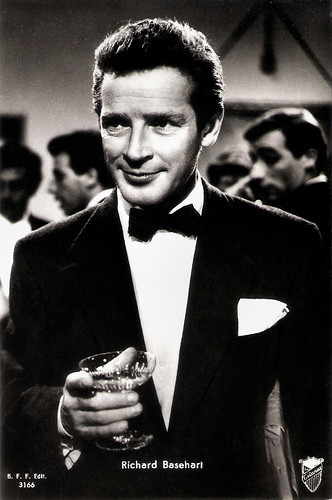
Italian postcard by B.F.F. Edit., no. 3166. Photo: G.B. Poletto /Titanus. Richard Basehart in Il bidone/The Swindlers (Federico Fellini, 1955).
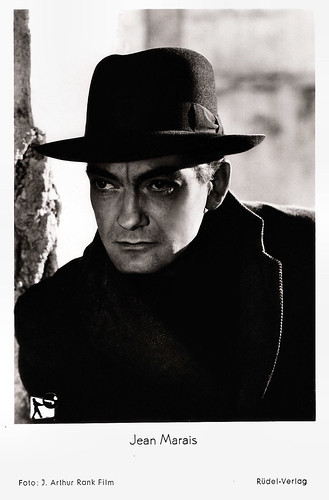
German postcard by Rüdel-Verlag, Hamburg-Bergedorf, no. 2141. Photo: G. B. Poletto / J. Arthur Rank Film. Jean Marais in Le notti bianche/ White Nights (Luchino Visconti, 1957).
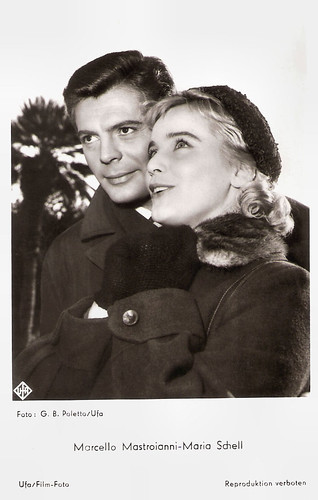
German postcard by Ufa, Berlin-Tempelhof, no. FK 3486. Photo: G.B. Poletto. Marcello Mastroianni and Maria Schell in Le notti bianche/ White Nights (Luchino Visconti, 1957).
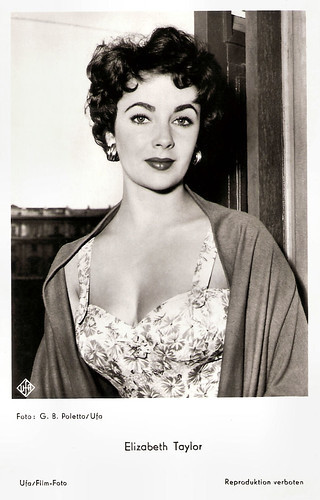
German postcard by Ufa, Berlin-Tempelhof, no. FK 3515. Photo: G.B. Poletto / Ufa.
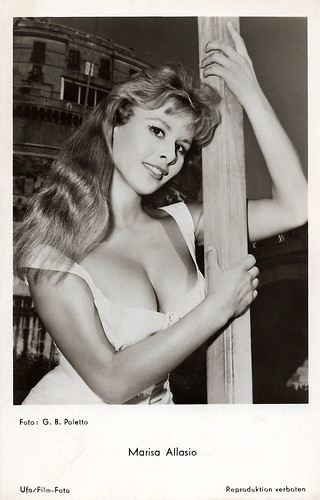
German postcard by Ufa/Filmfoto, Berlin-Tempelhof, no. FK 3476. Photo: G.B. Poletto.
The Leopard
Giovanni Battista Poletto himself told how the two masters Luchino Visconti and Federico Fellini related with him on the set in a totally different way: how much the one was inclined to give him all the space and time necessary to take the photos, so much the other was also annoyed by the only 'click' of the machine (despite the invention of the 'blimp' had significantly attenuated the click noise).
He worked with the Rimini director in Il bidone (Federico Fellini, 1955), with Richard Basehart and Broderick Crawford , and in Roma/Rome (Federico Fellini, 1972), an autobiographical tale in which Gore Vidal and Anna Magnani appear, in her latest film appearance. It is no coincidence that her images were selected for an exhibition dedicated to the actress in the Palazzo Valentini, Rome in 2008.
The relationship with Luchino Visconti was also intense: from Siamo donne to the masterpiece Il gattopardo/The Leopard (Luchino Visconti, 1963), the sum of his professional career. Precisely on this particularly long and demanding set, he chose to bring the family with him, although he usually kept work separate from his private world. In 2013, the photos of the making of the film were exhibited on the occasion of an important exhibition organised to celebrate the fiftieth anniversary of the film in Palazzo dei Normanni, Palermo.
1963 was a year of transition: the Titanus, due to the enormous production costs of Sodoma and Gomorrah (Robert Aldrich, 1962) and Il Gattopardo, went bankrupt as a production company continuing to deal only with the distribution.
The most important phase of Poletto's career therefore ended, coinciding with the heyday of Italian cinema, during which he was able to photograph works by authors such as Francesco Maselli (Gli sbandati/Abandoned, 1955), Mario Monicelli (Un eroe dei nostri tempi/A Hero of Our Times, 1955; Risate di gioia/The Passionate Thief, 1960), Vittorio De Sica (Il tetto/The Roof, 1956), Valerio Zurlini (Estate violenta/Violent Summer, 1959; La ragazza con la valigia/Girl with a Suitcase, 1961; Cronaca familiare/Family Diary, 1962), Nanni Loy (Audace colpo dei soliti ignoti/Fiasco in Milan, 1959; Le quattro giornate di Napoli/The Four Days of Naples, 1962), Francesco Rosi (I magliari/The Swindlers, 1959), Elio Petri (L'assassino/The Assassin, 1961; I giorni contati/His Days Are Numbered, 1962), Ermanno Olmi (Il posto/The Job, 1961), and Dino Risi (Operazione San Gennaro/The Treasure of San Gennaro, 1966).
His professional career seemed in some ways to follow the fate of still photography: it experienced its peak period in the 1950s and early 1960s and its progressive decline between the late 1960s and early 1970s, with the growing popularity of the television and the consequent decrease in budgets for cinema. On the contrary, the activity of his printing laboratory continued to be intense, often allowing him to indulge his natural inventiveness: in 1968 he was asked for a poster to advertise C'era una volta il West/Once Upon a Time in the West (Sergio Leone, 1968) and, for realising it, after a meticulous preparation as it was in his style, he created a special enlarger. He had repeatedly expressed his displeasure at not having followed in the footsteps of his maternal grandfather, an inventor of machinery.
In the second phase of his career, he still filmed genre films (Musicarelli in the first place), but he also documented the sets of some significant works such as Io la conoscevo bene/I knew her well (Antonio Pietrangeli, 1965) with Stefania Sandrelli , the Spaghetti Western I lunghi giorni della vendetta (Faccia d'angelo)/Days of Vengeance (Florestano Vancini, 1967) starring Giuliano Gemma , Romeo and Juliet (Franco Zeffirelli, 1968), and La prima notte di quiete/Indian Summer (Valerio Zurlini, 1972), starring Alain Delon .
The last film he worked for was the acclaimed comedy-drama Pane e cioccolata/Bread and Chocolate (Franco Brusati, 1973), starring Nino Manfredi , his close friend. Until the end, he continued to devote himself full time to his photographic laboratory, where his daughter Donatella had started working since 1966. Giovanni Battista Poletto died in Rome in 1988. He was 72.
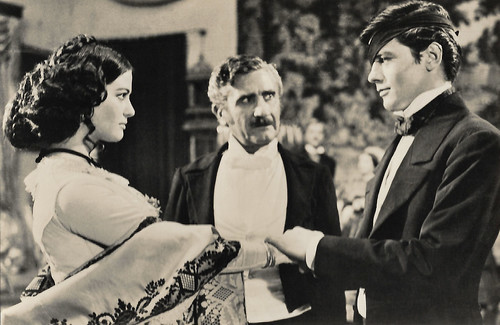
Small Czech collectors card by Pressfoto, Praha (Prague), 1965, no. S 101/6. Photo: G.B. Poletto. Claudia Cardinale , Paolo Stoppa and Alain Delon in Il gattopardo/The Leopard (Luchino Visconti, 1963).
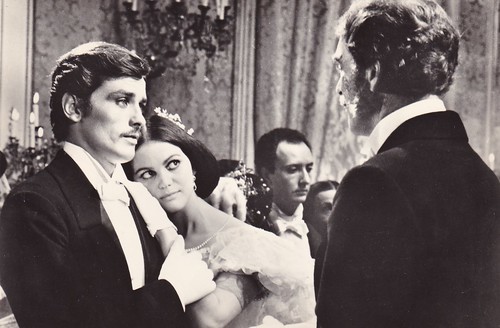
Czech postcard by Pressfoto, Praha (Prague). Photo: G.B. Poletto. Alain Delon , Claudia Cardinale and Burt Lancaster in Il Gattopardo/The Leopard (Luchino Visconti, 1963). Collection: Carla Bosch.
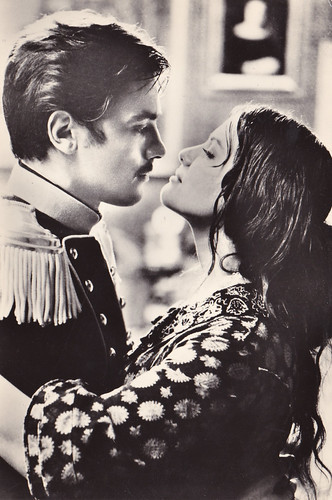
Czech postcard by Pressfoto, Praha (Prague). Photo: G.B. Poletto. Alain Delon and Claudia Cardinale in Il Gattopardo/The Leopard (Luchino Visconti, 1963). Collection: Carla Bosch.
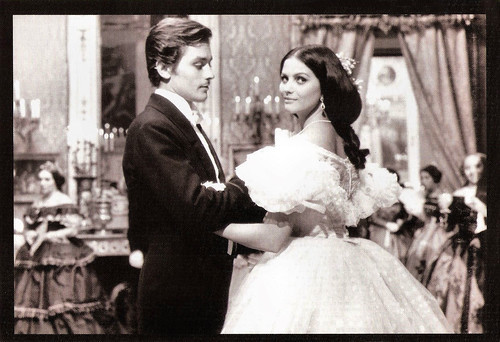
Vintage card. Photo: G.B. Poletto. Alain Delon and Claudia Cardinale in Il Gattopardo/The Leopard (Luchino Visconti, 1963).
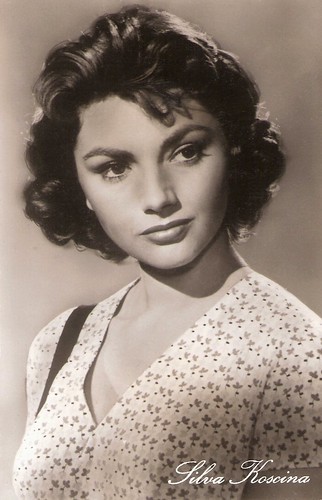
East-German postcard by VEB Progress Film-Vertrieb, Berlin, no. 1021, 1959. Retail price: 0,20 DM. Photo: G.B. Poletto, Rome.
Italian actress Sylva Koscina (1933-1994) may be best-remembered as Iole, the bride of Steve Reeves in the original version of Hercules (1958). She also starred in several Italian and Hollywood comedies of the 1950s and 1960s.
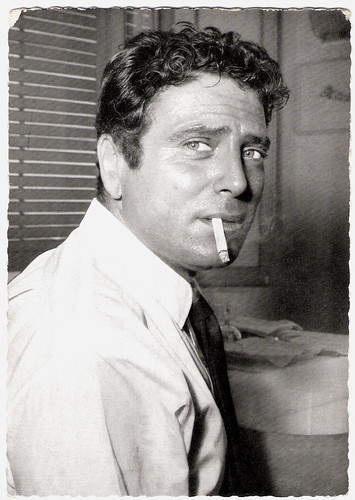
German postcard by Filmbilder-Vertrieb Ernst Freihoff, Essen, no. 224. Retail price: 10 Pfg. Photo: G.B. Poletto / Ufa.
Athletic Italian actor Raf Vallone (1916-2002) was an internationally acclaimed film star, known for his rugged good looks.

Italian postcard by Bromofoto, Milano, no. 1643. Photo G.B. Poletto / Titanus. Nino Manfredi in Audace colpo dei soliti ignoti/Fiasco in Milan (Nanni Loy, 1960).
Italian actor Nino Manfredi (1921-2004) was one of the most prominent stars in the Commedia all'italiana genre. He was equally adept at drama and comedy, and also had success as a film director and screenwriter.
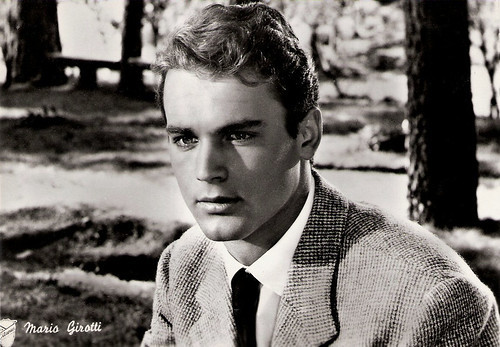
Italian postcard by Bromofoto, Milano (Milan), no. 1807. Photo: G.B. Poletto / Titanus. Mario Girotti (Terence Hill) in Lazzarella (Carlo Ludovico Bragaglia, 1957).
Sources: Giulia Della Torre, Riccardo Della Torre (Dizionario Biografico degli Italiani – Italian), and .

German postcard by Universum-Film Aktiengesellschaft (UFA), Berlin-Tempelhof, no. CK-174. Retail price: 30 Pfg. Photo: G.B. Poletto / UFA.
Italian actress Marisa Allasio (1936) was a glamorous starlet who appeared in nearly twenty pictures in the 1950s. She was nicknamed ‘The Italian Jayne Mansfield’. In 1958 her career stopped abruptly when she married and became a countess.

Yugoslavian postcard by NPO, no. G5. Photo: G.B. Poletto. Gina Lollobrigida and donkey in Pane, amore e fantasia /Bread, Love and Dreams (Luigi Comencini, 1953).

Italian postcard in the I Carabinieri nel Cinema series. Photo: Titanus. Photo: G.B. Poletto. Roberto Risso , Gina Lollobrigida and Vittorio De Sica in Pane, amore e gelosia/Bread, Love and Jealousy (Luigi Comencini, 1954).

Italian postcard by Casa Editr. Ballerini & Fratini, Firenze (B.F.F. Edit.), no. 3197. Photo: G.B. Poletto. Titanus. Antonio Cifariello in Pane, amore e...../Scandal in Sorrento (Dino Risi, 1955).

German postcard by UFA, Berlin-Tempelhof, no. 58. Retail price: 50 Pfg. Photo: G.B. Poletto / UFA.
Sex symbol Martine Carol (1920-1967) was one of the most beautiful women of the French cinema. During the early 1950s, she was a top box office draw as an elegant blonde seductress. Her private life was filled with turmoil including a suicide attempt, drug abuse, a kidnapping, and her mysterious death.
Poor But Beautiful
Giovanni Battista Poletto was born in Rome in 1915. His parents were Vittorio Poletto, originally from Rovigo, and Assunta Battistini, from Cesena. He attended elementary school in the Pinciano district, where he was born, and once he obtained a middle school license, he decided not to continue his studies.
In the 1930s he enrolled in a course for aviation photographers organised by the Air Force Ministry. Shortly thereafter, he began his career as a professional photographer at Ala Littoria, taking aerial photographs. During the war, he served in the aeronautics as a laboratory photographer. Transferred to Volta Mantovana, in 1943, he met the eighteen-year-old Paola Panizza, whom he married in 1946. Four children were born from the wedding: Donatella (1947), Carlo (1949), Laura (1953) and Alessandra (1958).
Once back in Rome with his wife, Poletto abandoned aerial photography in favour of reportage photography. He began to collaborate with such magazines as L’Europeo and Oggi and started his first contact with the world of cinema. In 1949 he met Roberto Rossellini, who wanted him as a set photographer of Stromboli, terra di Dio/Stromboli (Roberto Rossellini, 1950), starring Ingrid Bergman .
In 1950, the producer Goffredo Lombardo, head of one of the major studios, Titanus, offered him an exclusive contract, which committed him to be the still photographer for all the films produced by the studio. To cope with the growing amount of work, Poletto was forced to significantly expand the number of employees of his Agenzia Poletto - opened just before in the centre of Rome, in Via della Mercede 16 - which came to count 19 employees including photographers and printers.
For 'G.B. Poletto' - as he used to sign his photos - the first half of the 1950s was very intense on a professional level, with an average coverage of eleven sets per year. In 1951, he worked twice with the director and writer Mario Soldati, for the comedy O.K. Nerone/O.K. Nero (1951) starring Walter Chiari and Silvana Pampanini , and for È l'amor che mi rovina/It is love that ruins me (1951), with Chiari and Lucia Bosé .
In 1952, he photographed two episodes of Les sept péchés capitaux/The Seven Deadly Sins: L'Envie/Envy by Roberto Rossellini, and L'Avarice et la colère/Avarice and Anger by Eduardo De Filippo . With De Filippo, he also worked in the same year in the comedies Marito e moglie/Husband and wife (1952) and Ragazze da marito/Married Girls (1952).
The following year, he witnessed the directorial debut of Antonio Pietrangeli with Il sole negli occhi/The sun in his eyes (1953), for which the director earned a Silver Ribbon. He also made the still photos of Un marito per Anna Zaccheo/A husband for Anna Zaccheo (1954) by Giuseppe De Santis with whom he also collaborated for Uomini e lupi/Men and Wolves (Giuseppe De Santis, 1957) and Roberto Rossellini's Viaggio in Italia/Journey to Italy (1954), with whom he had built up mutual esteem and friendship in the meantime.
He resumed the sets of Pane, amore e fantasia/Bread, Love and Dreams (Luigi Comencini, 1953) with Vittorio De Sica and Gina Lollobrigida , and Poveri ma belli/Poor But Beautiful (Dino Risi, 1957), starring Marisa Allasio , Maurizio Arena , and Renato Salvatori . Of these popular 'sagas', he photographed all the sequels too.
Poletto also collaborated with Michelangelo Antonioni for La Signora senza Camelie/The Lady Without Camelias (1953), of which the photos depicting the young protagonist, Lucia Bosé , hover in memory.
In the same year, he worked on the set of Quand tu liras cette lettre/When You Read This Letter (Jean-Pierre Melville, 1953) with Juliette Gréco , and of the anthology film Siamo donne (Gianni Franciolini, Alfredo Guarini, Roberto Rossellini, Luchino Visconti, Luigi Zampa, 1953), starring Alida Valli , Ingrid Bergman , Isa Miranda , and Anna Magnani , of which he did all five episodes.
At the same time, he was on the sets of important authors of genre films: Raffaello Matarazzo, a prolific director of such melodramas as Chi è senza peccato..../Who is without sin ... (1952) and Torna!/Tears of Love (1954), and comedy directors like Camillo Mastrocinque for Attanasio, cavallo vanesio/Athanasius, the vain horse(1953) and Steno for Mio figlio Nerone/My son Nero (1956).

Italian postcard by Casa Editr. Ballerini & Fratini, Firenze, no. 3407. Photo: G.B. Poletto / Paramount / Titanus. Marisa Allasio in Poveri ma belli/Poor but beautiful (Dino Risi, 1957).

Italian postcard by Casa Edit. Ballerini & Fratini, Firenze (B.F.F.), no. 3579. Photo: G.B. Poletto / Titanus
Alessandra Panaro (1939-2019) was an Italian film actress of the late 1950s and early 1960s. She is best known for Luchino Visconti's crime drama Rocco e i suoi fratelli/Rocco and His Brothers (1960).

Italian postcard by B.F.F. Edit. (Casa Editr. Ballerini & Fratini, Firenze), no. 3580. Photo: G.B. Poletto / Titanus.
After her 'discovery' at the age of 14, Italian actress Lorella De Luca (1940-2014) played naïve young girls in several dramas and comedies. These made her one of the best-known ingénues of the Italian cinema of the late 1950s. De Luca was married to film director Duccio Tessari.

Italian postcard by B.F.F. Edit. (Casa Editr. Ballerini & Fratini, Firenze), no. 3712. Photo: G.B. Poletto / Titanus. Renato Salvatori in Poveri Millionari/Poor Millionaires (Dino Risi, 1959).
Renato Salvatori (1933-1988) was a popular, good-looking Italian actor of the 1950s and 1960s. His apex was his role as Simone in Visconti’s Rocco e i suoi fratelli/Rocco and His Brothers (1960).

Italian postcard by Casa Editr. Ballerini & Fratini, Firenze, no. 3713. Photo: G.B. Poletto / Titanus. Maurizio Arena in Poveri milionari/Poor Millionaires (Dino Risi, 1958).
Italian film actor Maurizio Arena (1933-1979) appeared in 78 films between 1952 and 1978. In the late 1950s, he became popular as the poor but handsome Roman working-class boy in a comedy trilogy by Dino Risi.
Federico Fellini
G.B. Poletto was among the photographers who contributed to launching Sophia Loren as one of the main divas of Italian cinema: the set photos of Il segno di Venere/The Sign of Venus (Dino Risi, 1955) and the promotional photos of Peccato che sia una canaglia/Too Bad She's Bad (Alessandro Blasetti, 1955), are still today among the most recognisable shots of the actress.
Titanus was always careful to diversify its offer, producing films by Rossellini, Federico Fellini, Luchino Visconti, high budget films in French and American co-productions, but also Italian comedies, melodramas, adventure films, Peplums. This mixture of author films and more widely consumed films reverberated on Poletto's work and represented a constant in his work, especially in the second part of his career.
From the mid-sixties, he often photographed the 'Musicarelli', hugely popular musical comedies starring the most famous pop singers of the time. Among these are Non son degno di te/I am not worthy of you (Ettore Maria Fizzarotti, 1965) with Gianni Morandi , and Non stuzzicate la zanzara/Don't whet the mosquito (Lina Wertmüller, 1967), starring Rita Pavone .
In his professional career, he also met Alberto Lattuada, with whom he collaborated for La spiaggia/Riviera (Alberto Lattuada, 1954) with Martine Carol , and Scuola elementare/Elementary school (Alberto Lattuada, 1955). The relationship with the Milanese director continued in 1960 with Lettere di una novizia/Letters by a Novice (Alberto Lattuada, 1960) and I Dolci decanni/Sweet Deceptions (Alberto Lattuada, 1960). The protagonist of this last film was Catherine Spaak , in the role of a teenager in love with a man much older than her. The film caused a sensation and was subjected to a very long censorship odyssey until 1964 when Lattuada and the producer Lombardo were acquitted of the accusation of obscenity.
In one of his few interviews, Poletto underlined how in Italy, unlike what happened in American cinema, the photographer was called to simultaneously cover multiple roles: to produce the promotional material of the film (envelopes for the press, posters) he had to faithfully resume what had been shot by the camera, preserving its angle of observation, and at the same time had to "document the birth of the film by shooting the director, the actors, the technicians at work or in moments of pause".
The 'still photography', as it was commonly understood, therefore constituted only a part of the photographer's overall work, not including the less quoted 'set photography' which left him more expressive freedom and which dissociated himself from the idea of cinema as a machine producing illusions "revealing 'the artifice'". Initially, the set, as the main place of the cinematographic creation, was not crossed by the photographer's eye. Later, Poletto began to show the space in which the film was physically made to further increase its charm and the power of seduction.
His colour images of Giulietta degli spiriti/Juliet of the Spirits (Federico Fellini, 1965) are famous. Poletto, widening the frame, shows the 'trick' hidden by the camera: the crane that supports the swing on which Sandra Milo swirls. He made photos of various kinds of sets, but it is clear that his gaze was mainly - and not only for evident advertising purposes - to the actors, the directors, and the relationship that was born between them during filming.

Italian postcard by B.F.F. Edit., no. 3166. Photo: G.B. Poletto /Titanus. Richard Basehart in Il bidone/The Swindlers (Federico Fellini, 1955).

German postcard by Rüdel-Verlag, Hamburg-Bergedorf, no. 2141. Photo: G. B. Poletto / J. Arthur Rank Film. Jean Marais in Le notti bianche/ White Nights (Luchino Visconti, 1957).

German postcard by Ufa, Berlin-Tempelhof, no. FK 3486. Photo: G.B. Poletto. Marcello Mastroianni and Maria Schell in Le notti bianche/ White Nights (Luchino Visconti, 1957).

German postcard by Ufa, Berlin-Tempelhof, no. FK 3515. Photo: G.B. Poletto / Ufa.

German postcard by Ufa/Filmfoto, Berlin-Tempelhof, no. FK 3476. Photo: G.B. Poletto.
The Leopard
Giovanni Battista Poletto himself told how the two masters Luchino Visconti and Federico Fellini related with him on the set in a totally different way: how much the one was inclined to give him all the space and time necessary to take the photos, so much the other was also annoyed by the only 'click' of the machine (despite the invention of the 'blimp' had significantly attenuated the click noise).
He worked with the Rimini director in Il bidone (Federico Fellini, 1955), with Richard Basehart and Broderick Crawford , and in Roma/Rome (Federico Fellini, 1972), an autobiographical tale in which Gore Vidal and Anna Magnani appear, in her latest film appearance. It is no coincidence that her images were selected for an exhibition dedicated to the actress in the Palazzo Valentini, Rome in 2008.
The relationship with Luchino Visconti was also intense: from Siamo donne to the masterpiece Il gattopardo/The Leopard (Luchino Visconti, 1963), the sum of his professional career. Precisely on this particularly long and demanding set, he chose to bring the family with him, although he usually kept work separate from his private world. In 2013, the photos of the making of the film were exhibited on the occasion of an important exhibition organised to celebrate the fiftieth anniversary of the film in Palazzo dei Normanni, Palermo.
1963 was a year of transition: the Titanus, due to the enormous production costs of Sodoma and Gomorrah (Robert Aldrich, 1962) and Il Gattopardo, went bankrupt as a production company continuing to deal only with the distribution.
The most important phase of Poletto's career therefore ended, coinciding with the heyday of Italian cinema, during which he was able to photograph works by authors such as Francesco Maselli (Gli sbandati/Abandoned, 1955), Mario Monicelli (Un eroe dei nostri tempi/A Hero of Our Times, 1955; Risate di gioia/The Passionate Thief, 1960), Vittorio De Sica (Il tetto/The Roof, 1956), Valerio Zurlini (Estate violenta/Violent Summer, 1959; La ragazza con la valigia/Girl with a Suitcase, 1961; Cronaca familiare/Family Diary, 1962), Nanni Loy (Audace colpo dei soliti ignoti/Fiasco in Milan, 1959; Le quattro giornate di Napoli/The Four Days of Naples, 1962), Francesco Rosi (I magliari/The Swindlers, 1959), Elio Petri (L'assassino/The Assassin, 1961; I giorni contati/His Days Are Numbered, 1962), Ermanno Olmi (Il posto/The Job, 1961), and Dino Risi (Operazione San Gennaro/The Treasure of San Gennaro, 1966).
His professional career seemed in some ways to follow the fate of still photography: it experienced its peak period in the 1950s and early 1960s and its progressive decline between the late 1960s and early 1970s, with the growing popularity of the television and the consequent decrease in budgets for cinema. On the contrary, the activity of his printing laboratory continued to be intense, often allowing him to indulge his natural inventiveness: in 1968 he was asked for a poster to advertise C'era una volta il West/Once Upon a Time in the West (Sergio Leone, 1968) and, for realising it, after a meticulous preparation as it was in his style, he created a special enlarger. He had repeatedly expressed his displeasure at not having followed in the footsteps of his maternal grandfather, an inventor of machinery.
In the second phase of his career, he still filmed genre films (Musicarelli in the first place), but he also documented the sets of some significant works such as Io la conoscevo bene/I knew her well (Antonio Pietrangeli, 1965) with Stefania Sandrelli , the Spaghetti Western I lunghi giorni della vendetta (Faccia d'angelo)/Days of Vengeance (Florestano Vancini, 1967) starring Giuliano Gemma , Romeo and Juliet (Franco Zeffirelli, 1968), and La prima notte di quiete/Indian Summer (Valerio Zurlini, 1972), starring Alain Delon .
The last film he worked for was the acclaimed comedy-drama Pane e cioccolata/Bread and Chocolate (Franco Brusati, 1973), starring Nino Manfredi , his close friend. Until the end, he continued to devote himself full time to his photographic laboratory, where his daughter Donatella had started working since 1966. Giovanni Battista Poletto died in Rome in 1988. He was 72.

Small Czech collectors card by Pressfoto, Praha (Prague), 1965, no. S 101/6. Photo: G.B. Poletto. Claudia Cardinale , Paolo Stoppa and Alain Delon in Il gattopardo/The Leopard (Luchino Visconti, 1963).

Czech postcard by Pressfoto, Praha (Prague). Photo: G.B. Poletto. Alain Delon , Claudia Cardinale and Burt Lancaster in Il Gattopardo/The Leopard (Luchino Visconti, 1963). Collection: Carla Bosch.

Czech postcard by Pressfoto, Praha (Prague). Photo: G.B. Poletto. Alain Delon and Claudia Cardinale in Il Gattopardo/The Leopard (Luchino Visconti, 1963). Collection: Carla Bosch.

Vintage card. Photo: G.B. Poletto. Alain Delon and Claudia Cardinale in Il Gattopardo/The Leopard (Luchino Visconti, 1963).

East-German postcard by VEB Progress Film-Vertrieb, Berlin, no. 1021, 1959. Retail price: 0,20 DM. Photo: G.B. Poletto, Rome.
Italian actress Sylva Koscina (1933-1994) may be best-remembered as Iole, the bride of Steve Reeves in the original version of Hercules (1958). She also starred in several Italian and Hollywood comedies of the 1950s and 1960s.

German postcard by Filmbilder-Vertrieb Ernst Freihoff, Essen, no. 224. Retail price: 10 Pfg. Photo: G.B. Poletto / Ufa.
Athletic Italian actor Raf Vallone (1916-2002) was an internationally acclaimed film star, known for his rugged good looks.

Italian postcard by Bromofoto, Milano, no. 1643. Photo G.B. Poletto / Titanus. Nino Manfredi in Audace colpo dei soliti ignoti/Fiasco in Milan (Nanni Loy, 1960).
Italian actor Nino Manfredi (1921-2004) was one of the most prominent stars in the Commedia all'italiana genre. He was equally adept at drama and comedy, and also had success as a film director and screenwriter.

Italian postcard by Bromofoto, Milano (Milan), no. 1807. Photo: G.B. Poletto / Titanus. Mario Girotti (Terence Hill) in Lazzarella (Carlo Ludovico Bragaglia, 1957).
Sources: Giulia Della Torre, Riccardo Della Torre (Dizionario Biografico degli Italiani – Italian), and .
Published on May 27, 2020 22:00
May 26, 2020
Jean-Claude Pascal
Singer ánd actor Jean-Claude Pascal (1927-1992) was one of the romantic lovers of the French cinema in the 1950s. In 1961 he won the Eurovision Song Contest for Luxembourg singing 'Nous Les Amoureux'. In 1981 he was less successful with the song 'C'est peut-être pas l'Amérique'.

German postcard by Ufa, Berlin-Tempelhof, no. FK 824. Photo: Lucienne Chevert, Paris.

German postcard by Ufa, Berlin/Tempelhof, no. FK 1384. Photo: Sam Lévin / Union Film.
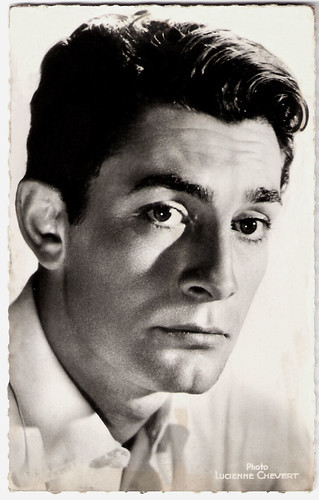
French postcard by Editions du Globe, Paris, no. 331. Photo: Lucienne Chevert.
[image error]
French postcard by Editions P.I., Paris, no. 529. Photo: Lucienne Chevert.

French autograph card. Photo: Sam Lévin.
Passion for Acting
Jean-Claude Pascal was born as Jean-Claude Henri Roger Villeminot in Paris in 1927, into a family of textile manufacturers.
In 1944, when he was 17, he voluntarily joined the 2e Division blindée (2nd Armored Division) with which he entered the still occupied Strasbourg. Pascal received the Croix de Guerre and later he became a Commandeur des Arts et Lettres and Chevalier de la Légion d'honneur (Legion of Honor).
After the Second World War, he studied at the Sorbonne university, but he started his career as a fashion designer for Hermès.
Later the handsome Pascal met Christian Dior and became his stylist and also his model. He designed the costumes for the stage production 'Don Juan' by Molière, directed by Louis Jouvet .
He then discovered his passion for acting. After attending the drama course of Arthur Ford, he made his stage debut in 1949, alongside Pierre Renoir and Edwige Feuillère in 'La Dame aux Camélias' (Camille). He took the stage name Jean-Claude Pascal.
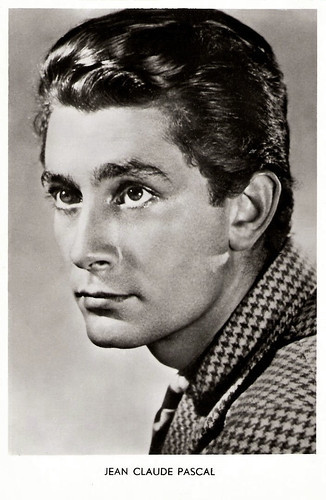
French postcard, no. 10.
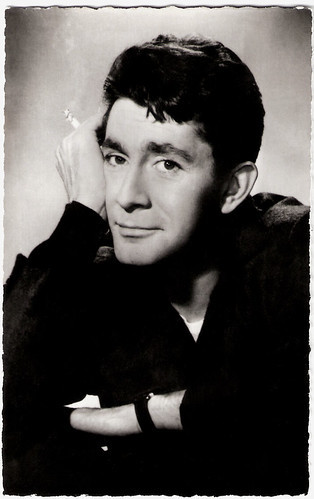
French postcard by Editions du Globe, Paris, no. 648. Photo: Sam Lévin.
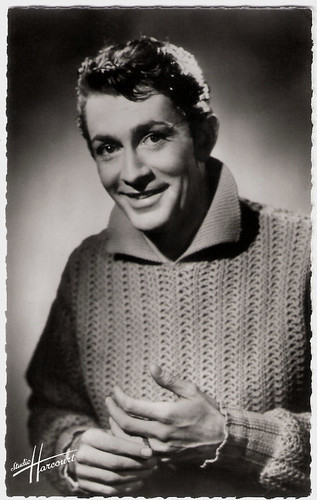
French postcard by Editions du Globe, Paris, no. 255. Photo: Studio Harcourt.
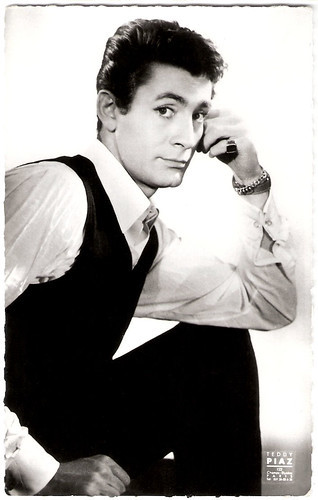
French postcard by Editions du Globe, Paris, no. 399. Photo: Teddy Piaz, Paris.
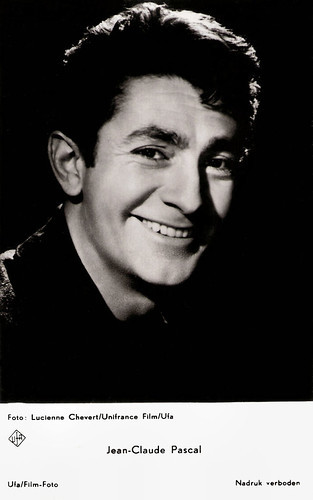
Dutch postcard by Gebr. Spanjersberg N.V, Rotterdam, no. 4109. Photo: Lucienne Chevert / Unifrance Film / Ufa.
Romantic Lover
Tall, slender, dark-eyed Jean-Claude Pascal became one of the romantic lovers of the French cinema in the 1950s. His first film as a jeune premier was in the Italian film Quattro rose rosse/Four Red Roses (Nunzio Malasomma, 1949) opposite Olga Villi and Fosco Giachetti .
In France, he appeared with Pierre Fresnay in Un grand patron/Perfectionist (Yves Ciampi, 1951). For this role, his hair was coloured blond.
The following years, he was often seen in costume opposite beautiful women in such films as Le rideau cramoisi/The Crimson Curtain (Alexandre Astruc, 1953) and Les Mauvaises rencontres/Bad Liaisons (Alexandre Astruc, 1955) both with Anouk Aimée , Le Chevalier de la nuit/Knight of the Night (Robert Darène, 1953) with Renée Saint-Cyr , Le Grand Jeu/Flesh and the Woman (Robert Siodmak, 1954) with Gina Lollobrigida , Le Salaire du péché/The Wages of Sin (Denys de La Patellière, 1956) opposite Danielle Darrieux , and Die schöne Lügnerin/The Beautiful Lier (Axel Von Ambesser, 1959) with Romy Schneider .
Although he often played a romantic womaniser on screen, there was no woman in his private life, except for his beloved mother. The French site Hexagon Gay writes that Pascal was gay and liked men: "Only the artistic and gay at the time were aware because it is totally excluded to reveal such an orientation in a society where homophobia is still the rule. (...) The longest relationship he maintained, was with the actor Jean Chevrier , who died in 1975."
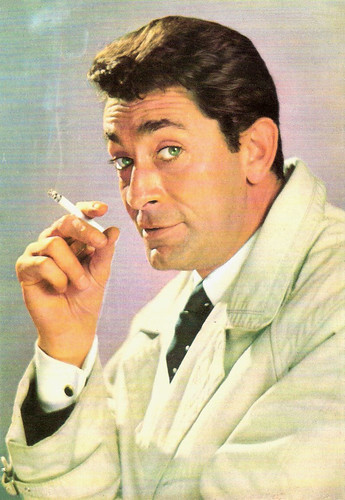
Spanish postcard by Toro de Bronze, no. 183, 1964. Photo: Sam Lévin.
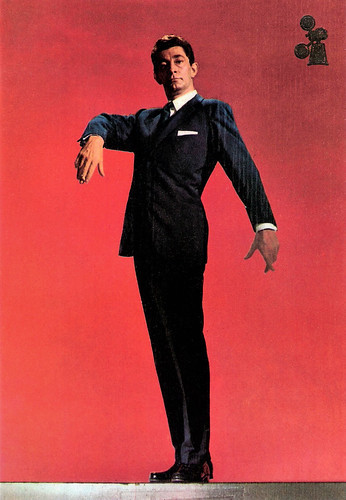
Spanish postcard by Postalcolor, Hospitalet (Barcelona), no. 89, 1964. Photo: Sam Lévin.
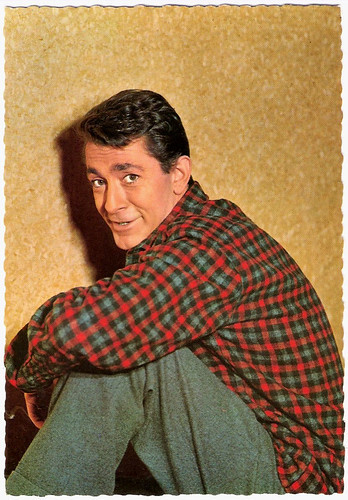
French postcard by E.D.U.G., no. 203. Photo: Studio Pietri.
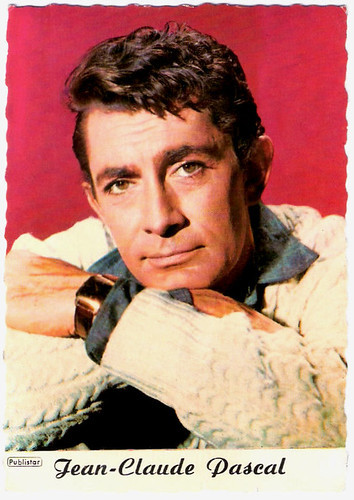
French collectors card by Publistar.
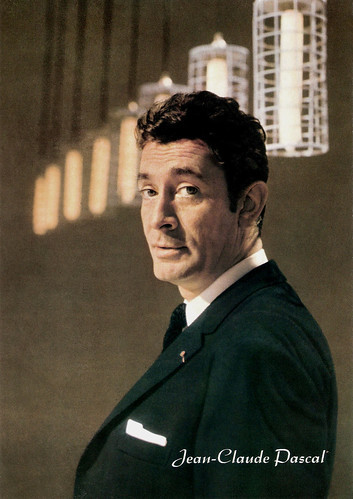
Big East-German card by VEB Lied der Zeit Musikverlag, Berlin, no. 419-440/A 508/69, 1969. Photo: H.J. Hoffmann.
Eurovision
The filmmakers of the Nouvelle Vague were not interested in Jean-Claude Pascal. His film work diminished in the 1960s and he switched to singing chansons such as 'Lily Marlene' in both German and French.
His sultry, deep voice served sensitive interpretations of songs of such (then) young writers as Guy Béart, Serge Gainsbourg and Jean Ferrat. In 1962, he was awarded the Prix de l' Académie Charles-Cros for it.
In 1961 he won the Eurovision Song Contest for Luxembourg singing 'Nous Les Amoureux' (We the Lovers) with music composed by Jacques Datin and lyrics by Maurice Vidalin.
Twenty years later he represented Luxembourg again at the Eurovision Song contest 1981 with 'C'est peut-être pas l'Amérique' (It may not be America) but finished 11th of 20. He composed the words and music of this song himself along with Sophie Makhno and Jean-Claude Petit.
In the meantime he incidentally played in such light entertainment films as Le Rendez-vous/Rendezvous (Jean Delannoy, 1961) with Annie Girardot , the Spanish comedy Las 4 bodas de Marisol/The Four Marriages of Marisol (Luis Lucia, 1967) opposite the young Spanish idol Marisol , and Angélique et le Sultan/Angelique and the Sultan (Bernard Borderie, 1968) with Michèle Mercier .
His last film was the German Krimi Unter den Dächern von St. Pauli/Under the Roofs of St. Pauli (Alfred Weidenmann, 1970). In the 1970s he worked for television and the stage and in the 1980s he wrote detective novels and historical portraits, like 'L'Amant du roi' (The King's Lover) and 'Marie Stuart' (Mary Stuart). In 1986 he published his autobiography 'Le Beau Masque' (The Beautiful Mask).
In 1992 Jean-Claude Pascal died of lung cancer in Clichy-la-Garenne, near Paris. He was 64. There was not much media attention for the passing of this quite forgotten star, who had been so popular during the 1950s and 1960s.
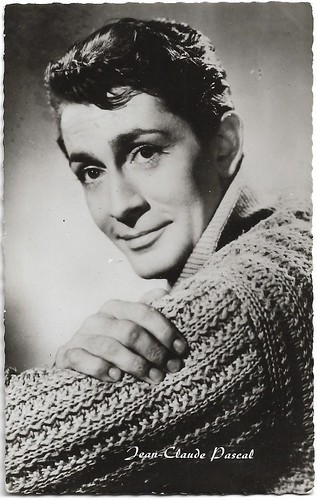
Dutch or Flemish postcard. Editor unknown.
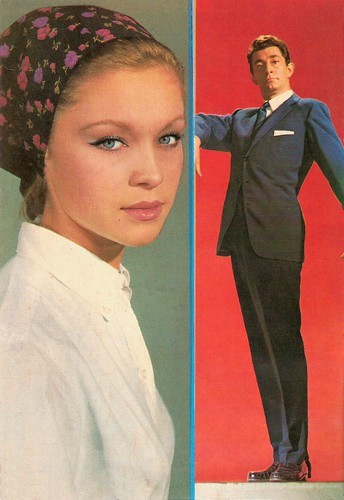
With Marisol . Spanish postcard by Postal Oscar Color, S.A., Hospitalet (Barcelona), no. 702. Publicity card for Las 4 bodas de Marisol/The Four Marriages of Marisol (Luis Lucia, 1967).
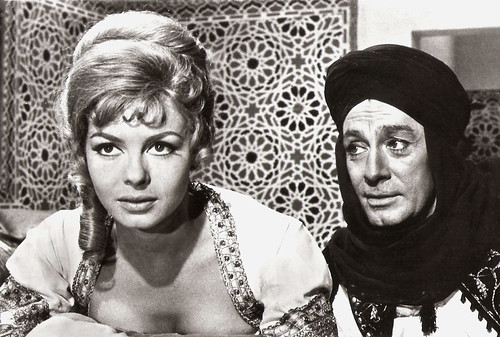
Romanian postcard by Casa Filmului Acin. Photo: Michèle Mercier and Jean-Claude Pascal in Angelique et le sultan/Angelique and the sultan (Bernard Borderie, 1966).
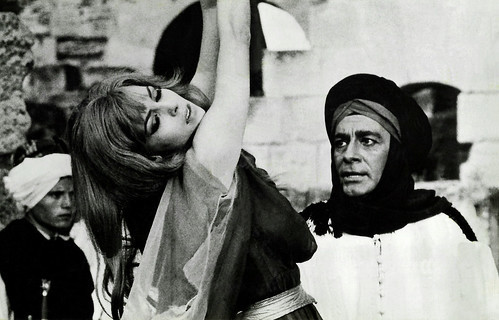
Romanian postcard by Casa Filmului Acin, no. 331. Photo: Michèle Mercier and Jean-Claude Pascal in Angelique et le sultan/Angelique and the sultan (Bernard Borderie, 1966).
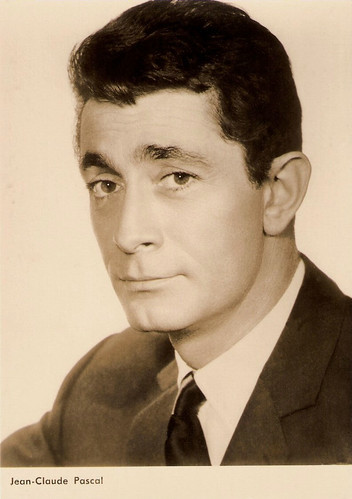
East-German postcard by VEB Progress Film-Vertrieb, Berlin, no. 3238, 1968. Retail price: 0,20 MDN. Photo: Steffen.
Jean-Claude Pascal sings 'Nous les amoureux' at the Eurovision Song contest 1961. Source: eurovisionfrancetube (YouTube). On 18March 1961, Jean-Claude represented Luxembourg in the Eurovision Song Contest 1961 in Cannes, France, and he won! With 31 points, he was ahead of the United Kingdom, Switzerland, France, and Denmark.
Jean-Claude Pascal sings 'C'est peut-être pas l'Amérique' at the Eurovision Song contest 1981. Source: Niindelos Taivos (YouTube).
Sources: Dave Thompson (AllMusic), Hexagone Gay (French), Wikipedia and .

German postcard by Ufa, Berlin-Tempelhof, no. FK 824. Photo: Lucienne Chevert, Paris.

German postcard by Ufa, Berlin/Tempelhof, no. FK 1384. Photo: Sam Lévin / Union Film.

French postcard by Editions du Globe, Paris, no. 331. Photo: Lucienne Chevert.
[image error]
French postcard by Editions P.I., Paris, no. 529. Photo: Lucienne Chevert.

French autograph card. Photo: Sam Lévin.
Passion for Acting
Jean-Claude Pascal was born as Jean-Claude Henri Roger Villeminot in Paris in 1927, into a family of textile manufacturers.
In 1944, when he was 17, he voluntarily joined the 2e Division blindée (2nd Armored Division) with which he entered the still occupied Strasbourg. Pascal received the Croix de Guerre and later he became a Commandeur des Arts et Lettres and Chevalier de la Légion d'honneur (Legion of Honor).
After the Second World War, he studied at the Sorbonne university, but he started his career as a fashion designer for Hermès.
Later the handsome Pascal met Christian Dior and became his stylist and also his model. He designed the costumes for the stage production 'Don Juan' by Molière, directed by Louis Jouvet .
He then discovered his passion for acting. After attending the drama course of Arthur Ford, he made his stage debut in 1949, alongside Pierre Renoir and Edwige Feuillère in 'La Dame aux Camélias' (Camille). He took the stage name Jean-Claude Pascal.

French postcard, no. 10.

French postcard by Editions du Globe, Paris, no. 648. Photo: Sam Lévin.

French postcard by Editions du Globe, Paris, no. 255. Photo: Studio Harcourt.

French postcard by Editions du Globe, Paris, no. 399. Photo: Teddy Piaz, Paris.

Dutch postcard by Gebr. Spanjersberg N.V, Rotterdam, no. 4109. Photo: Lucienne Chevert / Unifrance Film / Ufa.
Romantic Lover
Tall, slender, dark-eyed Jean-Claude Pascal became one of the romantic lovers of the French cinema in the 1950s. His first film as a jeune premier was in the Italian film Quattro rose rosse/Four Red Roses (Nunzio Malasomma, 1949) opposite Olga Villi and Fosco Giachetti .
In France, he appeared with Pierre Fresnay in Un grand patron/Perfectionist (Yves Ciampi, 1951). For this role, his hair was coloured blond.
The following years, he was often seen in costume opposite beautiful women in such films as Le rideau cramoisi/The Crimson Curtain (Alexandre Astruc, 1953) and Les Mauvaises rencontres/Bad Liaisons (Alexandre Astruc, 1955) both with Anouk Aimée , Le Chevalier de la nuit/Knight of the Night (Robert Darène, 1953) with Renée Saint-Cyr , Le Grand Jeu/Flesh and the Woman (Robert Siodmak, 1954) with Gina Lollobrigida , Le Salaire du péché/The Wages of Sin (Denys de La Patellière, 1956) opposite Danielle Darrieux , and Die schöne Lügnerin/The Beautiful Lier (Axel Von Ambesser, 1959) with Romy Schneider .
Although he often played a romantic womaniser on screen, there was no woman in his private life, except for his beloved mother. The French site Hexagon Gay writes that Pascal was gay and liked men: "Only the artistic and gay at the time were aware because it is totally excluded to reveal such an orientation in a society where homophobia is still the rule. (...) The longest relationship he maintained, was with the actor Jean Chevrier , who died in 1975."

Spanish postcard by Toro de Bronze, no. 183, 1964. Photo: Sam Lévin.

Spanish postcard by Postalcolor, Hospitalet (Barcelona), no. 89, 1964. Photo: Sam Lévin.

French postcard by E.D.U.G., no. 203. Photo: Studio Pietri.

French collectors card by Publistar.

Big East-German card by VEB Lied der Zeit Musikverlag, Berlin, no. 419-440/A 508/69, 1969. Photo: H.J. Hoffmann.
Eurovision
The filmmakers of the Nouvelle Vague were not interested in Jean-Claude Pascal. His film work diminished in the 1960s and he switched to singing chansons such as 'Lily Marlene' in both German and French.
His sultry, deep voice served sensitive interpretations of songs of such (then) young writers as Guy Béart, Serge Gainsbourg and Jean Ferrat. In 1962, he was awarded the Prix de l' Académie Charles-Cros for it.
In 1961 he won the Eurovision Song Contest for Luxembourg singing 'Nous Les Amoureux' (We the Lovers) with music composed by Jacques Datin and lyrics by Maurice Vidalin.
Twenty years later he represented Luxembourg again at the Eurovision Song contest 1981 with 'C'est peut-être pas l'Amérique' (It may not be America) but finished 11th of 20. He composed the words and music of this song himself along with Sophie Makhno and Jean-Claude Petit.
In the meantime he incidentally played in such light entertainment films as Le Rendez-vous/Rendezvous (Jean Delannoy, 1961) with Annie Girardot , the Spanish comedy Las 4 bodas de Marisol/The Four Marriages of Marisol (Luis Lucia, 1967) opposite the young Spanish idol Marisol , and Angélique et le Sultan/Angelique and the Sultan (Bernard Borderie, 1968) with Michèle Mercier .
His last film was the German Krimi Unter den Dächern von St. Pauli/Under the Roofs of St. Pauli (Alfred Weidenmann, 1970). In the 1970s he worked for television and the stage and in the 1980s he wrote detective novels and historical portraits, like 'L'Amant du roi' (The King's Lover) and 'Marie Stuart' (Mary Stuart). In 1986 he published his autobiography 'Le Beau Masque' (The Beautiful Mask).
In 1992 Jean-Claude Pascal died of lung cancer in Clichy-la-Garenne, near Paris. He was 64. There was not much media attention for the passing of this quite forgotten star, who had been so popular during the 1950s and 1960s.

Dutch or Flemish postcard. Editor unknown.

With Marisol . Spanish postcard by Postal Oscar Color, S.A., Hospitalet (Barcelona), no. 702. Publicity card for Las 4 bodas de Marisol/The Four Marriages of Marisol (Luis Lucia, 1967).

Romanian postcard by Casa Filmului Acin. Photo: Michèle Mercier and Jean-Claude Pascal in Angelique et le sultan/Angelique and the sultan (Bernard Borderie, 1966).

Romanian postcard by Casa Filmului Acin, no. 331. Photo: Michèle Mercier and Jean-Claude Pascal in Angelique et le sultan/Angelique and the sultan (Bernard Borderie, 1966).

East-German postcard by VEB Progress Film-Vertrieb, Berlin, no. 3238, 1968. Retail price: 0,20 MDN. Photo: Steffen.
Jean-Claude Pascal sings 'Nous les amoureux' at the Eurovision Song contest 1961. Source: eurovisionfrancetube (YouTube). On 18March 1961, Jean-Claude represented Luxembourg in the Eurovision Song Contest 1961 in Cannes, France, and he won! With 31 points, he was ahead of the United Kingdom, Switzerland, France, and Denmark.
Jean-Claude Pascal sings 'C'est peut-être pas l'Amérique' at the Eurovision Song contest 1981. Source: Niindelos Taivos (YouTube).
Sources: Dave Thompson (AllMusic), Hexagone Gay (French), Wikipedia and .
Published on May 26, 2020 22:00
Paul van Yperen's Blog
- Paul van Yperen's profile
- 13 followers
Paul van Yperen isn't a Goodreads Author
(yet),
but they
do have a blog,
so here are some recent posts imported from
their feed.



